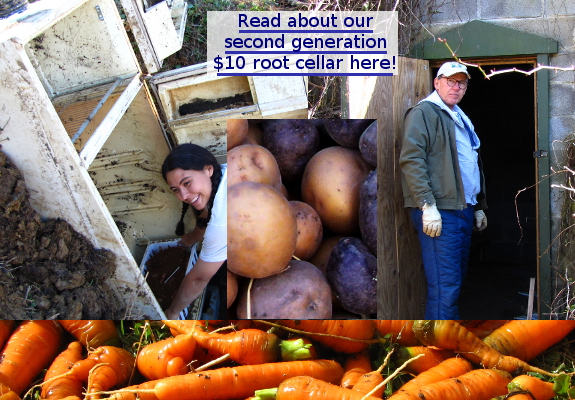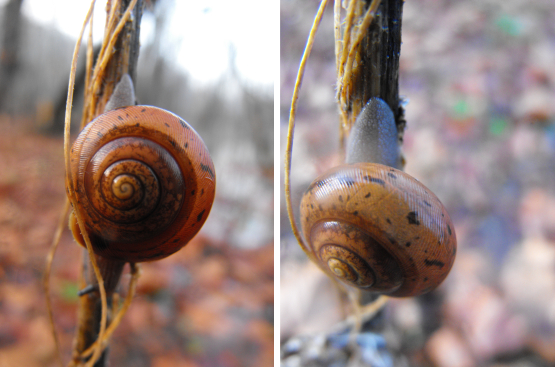
archives for 12/2009
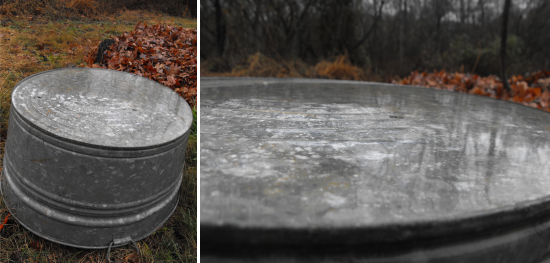
Mark and the farm are
training me to be more flexible, to resist my urge to set up trips
weeks in advance. Monday, I took a look at the weather forecast
and saw chilly rain all week with nights above freezing. Cold
rain is the absolute worst weather for working outside, and with the
warmish nights from the cloud cover we won't have to worry about our chickens' waterers
freezing. Time to head up to Ohio to visit with Marks' family!
I have to admit that my
new-found flexibility was due in part to not wanting to do our laundry
outside in the rain. I'm usually pretty hardcore, but now and
then I wimp out and look forward to using a real, live washing machine.
Warm water, here we come!
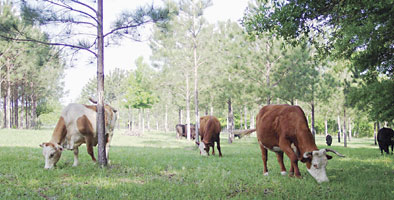 The USDA National
Agroforestry Center
is experimenting with ways to combine trees and pastures.
Livestock (primarily cows) are grazed between widely spaced pine trees
that are grown for timber. The cows don't eat the trees, but they
do benefit from the shade and wind shelter. If I was a large
scale farmer rather than a homesteader, I would find this idea
enticing, but I'm really looking for a system in which the plants and
animals are more intertwined.
The USDA National
Agroforestry Center
is experimenting with ways to combine trees and pastures.
Livestock (primarily cows) are grazed between widely spaced pine trees
that are grown for timber. The cows don't eat the trees, but they
do benefit from the shade and wind shelter. If I was a large
scale farmer rather than a homesteader, I would find this idea
enticing, but I'm really looking for a system in which the plants and
animals are more intertwined.
While looking into the
history of forest gardening, I stumbled upon Forest
Farming,
by J. Sholto Douglas and Robert A. de J. Hart. The book isn't a
riveting work of art and it spans too many climate zones to be a
useful how to book, but I was inspired by the presence of livestock in
the forest farm systems. Douglas and Hart suggest planting
pastures of trees that drop edible fruits and nuts to feed the
livestock. The multi-layered nature of the forest allows for
higher productivity than a single layer pasture can produce, and the
livestock add fertility back to the system with their manure.
| This post is part of our Forest Pasturing lunchtime series.
Read all of the entries: |
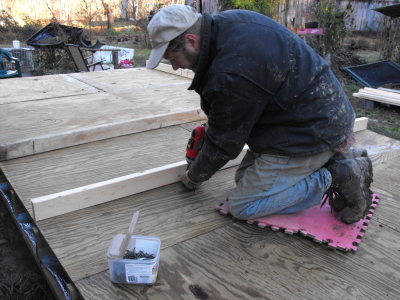 I learned a while back that a good set of knee
pads can make a big difference at the end of a day when you need to be
close to the ground. What I never got used to was how they tended to
cut off the circulation. My new favorite knee protector is this red
foam rubber pad. It provides a bit more wiggle room and doubles as a
place to sit when you need to take a break.
I learned a while back that a good set of knee
pads can make a big difference at the end of a day when you need to be
close to the ground. What I never got used to was how they tended to
cut off the circulation. My new favorite knee protector is this red
foam rubber pad. It provides a bit more wiggle room and doubles as a
place to sit when you need to take a break.
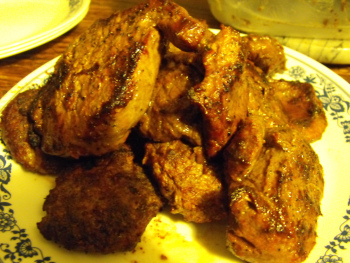 A couple of weeks after my
big kill, we've had time to try out a few venison recipes.
I've learned a lot, and find myself enamored of the taste, which seems
closer to high quality beef than anything else.
A couple of weeks after my
big kill, we've had time to try out a few venison recipes.
I've learned a lot, and find myself enamored of the taste, which seems
closer to high quality beef than anything else.
Our first and best
experiment was grilling
the tenderloin (on either side of the backbone) and upper ham (the top
of the "thigh" of the back legs). We let the meat marinate in oil
first since venison tends to be very lean, then rubbed it with some
salt and pepper before tossing it on the grill. That was so
delicious, we all ended up in rapture. Hard to beat.
For my second attempt, I
wanted to try some of the stew quality meat --- the front legs, the
lower parts of the ham, and other random spots around the deer. I
tried roasting the
venison up with some root vegetables, but I was disappointed ---
the taste was good, but I hadn't taken out all of the white stuff
(tendons?) that is so ubiquitous in the lower quality cuts of the
deer. The white stuff cooks up to be very chewy and hard to
eat. I considered this a failure, though Mark gamely munched his
way through and proclaimed it a success.
My third attempt went
much better. Again, I used some of the stew quality meat, but
this time I threw it in the food processor first to be chopped to
little bits. The white stuff stayed unchopped and was easy to
pull out, then I mixed up potsticker
filling with the remaining meat. Those were some of the best
potstickers we've ever eaten! More rapture.
For my next experiment
with the stew meat, I want to try to make Italian sausage. Stay
tuned....
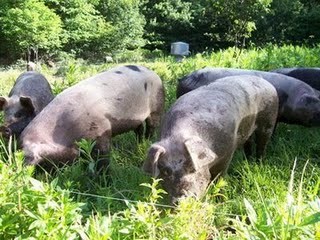 Although
pigs haven't really been the focus of our livestock fantasies in the
past, everything I read about forest farming pushes me toward
swine. Unlike goats and sheep, pigs aren't woody plant
eaters. In fact, once a tree exceeds two feet in height, they
tend to leave it alone. Although they are prone to root up the
soil, if pigs are rotated through several small pastures, they do
minimal damage.
Although
pigs haven't really been the focus of our livestock fantasies in the
past, everything I read about forest farming pushes me toward
swine. Unlike goats and sheep, pigs aren't woody plant
eaters. In fact, once a tree exceeds two feet in height, they
tend to leave it alone. Although they are prone to root up the
soil, if pigs are rotated through several small pastures, they do
minimal damage.
Mulberries were the
biggest factor that pointed me toward pigs. In Tree
Crops,
J. Russell Smith notes that an everbearing mulberry tree can provide
all of the food a pig needs for three solid months (from July through
September.) I would add in a chestnut tree and a persimmon tree
(to bear in the fall) and a honey locust tree (to bear in the early
winter), then count on my pigs getting a lot of their nutrition from
fresh green undergrowth in spring and early summer. It sounds
like I might be able to devise a system where I wouldn't need to feed
my pigs supplemental grain except in late winter.
Traditionally, farmers
around here used to turn their pigs loose in the
woods in the fall to fatten on fallen acorns, so oaks would be an
obvious addition to the pig forest pasture. However, I don't
think we'll include oaks in our plans since they tend to fruit heavily
only once every few years, which leaves gaps in our production cycle.
| This post is part of our Forest Pasturing lunchtime series.
Read all of the entries: |
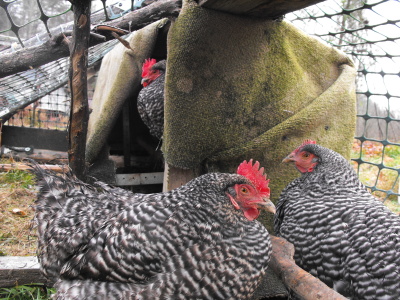 In the 4th generation of our home
made chicken tractors I decided to add a day time roost in addition
to the night time area. I don't have any proof, but I think it's good
for the morale of the flock to have multiple areas where a hen can be to
herself and get some personal space.
In the 4th generation of our home
made chicken tractors I decided to add a day time roost in addition
to the night time area. I don't have any proof, but I think it's good
for the morale of the flock to have multiple areas where a hen can be to
herself and get some personal space.
 Time for another daffodil
giveaway! I said it
best last year:
Time for another daffodil
giveaway! I said it
best last year:
Daffodils are a fact of life here at Wetknee Farm, one of the few remants of the previous owner who left decades before we arrived. When we first came to the farm, we discovered that daffodils had spread out from the old homeplace to cover nearly an acre of good garden ground. I gave away hundreds, sold hundreds, and ended up transplanted another thousand or so out of the way. Now the garden is once again encroaching on my daffodil patch --- time for a daffodil giveaway!
I don't know quite how many daffodil bulbs we'll be giving away. We've
got a couple of hundred at the moment, but we're also giving them away
with our Avian Aqua Miser
orders. So, whatever's left come January 1 will go to our lucky
winner.
To enter the
giveaway, just leave a comment on any post by December 31. I'll
throw your name in the hat (multiple times if you make multiple
comments)
then will contact the winner through the blog. (Be sure
to check back on January 1 to see if you won!) That way you
have an incentive to leave us lots of comments. I look
forward to hearing from you!
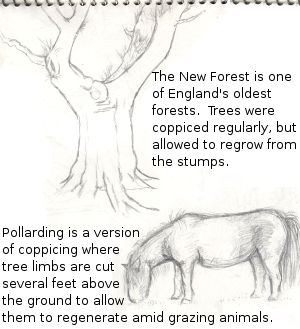 Sheep
and goats are a bit more difficult to grow in a forest pasture
situation since they like to eat twigs and thin-barked trees.
There is also less data available for good ways to combine these
livestock with trees, but I've got a couple of thoughts.
Sheep
and goats are a bit more difficult to grow in a forest pasture
situation since they like to eat twigs and thin-barked trees.
There is also less data available for good ways to combine these
livestock with trees, but I've got a couple of thoughts.
First, I suspect that
sheep and goats would work very well in the power
line cut if I planted it with trees that don't mind being coppiced
(willows, alders, hazels, and elders.) By rotating the sheep and
goats through small pastures, we could give the shrubs time to grow
back rather than being decimated by gnawing teeth.
We might also get away
with grazing sheep along with pigs amid large,
widely spaced trees. Unlike goats, sheep can live entirely on
pasture and they might eat up the woodier plants on the forest floor
that pigs would ignore.
| This post is part of our Forest Pasturing lunchtime series.
Read all of the entries: |
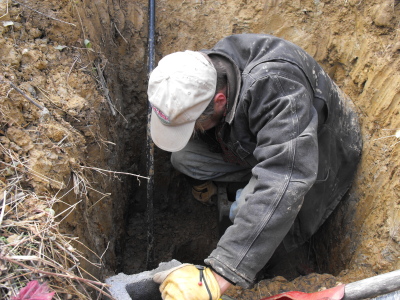 The palomino grain cow
hide work gloves are still my preferred glove for handling heavy
jobs. I estimate that the work load here at Wetknee seems to chew
through them somewhere between 9 and 12 months, which is a good value when you consider the wear and tear you're saving on each
hand.
The palomino grain cow
hide work gloves are still my preferred glove for handling heavy
jobs. I estimate that the work load here at Wetknee seems to chew
through them somewhere between 9 and 12 months, which is a good value when you consider the wear and tear you're saving on each
hand.
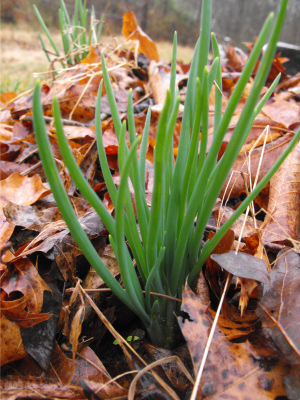 I keep getting questions from folks wanting to
know the difference between Egyptian onions, potato onions, shallots,
and multiplier onions. All are perennial onions that reproduce by
bulbs, and it's easy to confuse them.
I keep getting questions from folks wanting to
know the difference between Egyptian onions, potato onions, shallots,
and multiplier onions. All are perennial onions that reproduce by
bulbs, and it's easy to confuse them.
Egyptian onions (also known as walking onions) are easy to
distinguish because they reproduce by little bulbs at the top of leaf
stalks. They don't make big bulbs, so are best eaten as green
onions or scallions.
"Multiplier onion" is a term used to refer to any onion that reproduces
by dividing its underground bulbs (just like garlic does.)
Multiplier onions can be separated into two categories --- shallots
(which form bulbs up to 1.5 inches in diameter) and potato onions
(which form bulbs up to 3 inches in diameter.)
We're growing potato
onions for the first time this fall, and I have to say that I've
already decided I love them.
I carefully planted them in raised beds a month ago and mulched them
heavily with leaves. Then, just as everything else in the garden
and
woods was turning brown and dying, the potato onions shot up fresh,
green sprouts.
Hooray for perennial onions!
 All
this talk of rotational grazing makes Mark cringe because he knows it
means lots of fences. Is there a way to delete the fences and
instead add in more multi-purpose trees?
All
this talk of rotational grazing makes Mark cringe because he knows it
means lots of fences. Is there a way to delete the fences and
instead add in more multi-purpose trees?
When I was in Great
Britain, I loved their tradition of using hedgerows to
separate fields. The hedgerows consisted of closely planted trees
and shrubs, many of which produced fruits or nuts that could feed
livestock (or humans.)
Since our livestock
dreams are a few years in the future, we have time
to plant some hedges now in preparation. So far, the most
interesting edible hedge species I've read about include crab apples,
wild plums, Nanking cherry, trifoliate orange, blackberry, elder,
hazel, and rose. The goal is to plant them close enough together
that they create an impenetrable thicket and keep animals from breaking
through, but not so thickly that they drown each other out. I've
got a lot more reading to do on hedges, though, before I put anything
in the ground!
| This post is part of our Forest Pasturing lunchtime series.
Read all of the entries: |
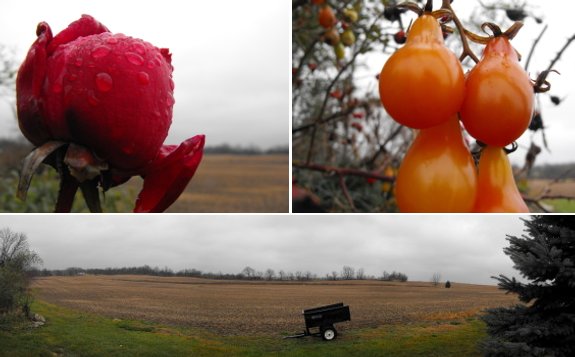
These are a few pictures from our peaceful trip up north where winter
feels just a couple of weeks stronger.
 We had a very fruitful visit to Ohio, both
literally and figuratively. I had my eyes peeled for useful seeds
and was thrilled to stumble upon a patch of honey locust and
osage-orange growing together in a floodplain. It was easy to
gather up two big bags of osage-orange
fruits to turn into a hedge, but I had to do some serious foraging
to find un-gnawed honey locust pods. I take this as a very good
sign --- if the wild animals are so fond of honey locust seeds,
hopefully our
idea of feeding honey locusts to pigs will pan out.
We had a very fruitful visit to Ohio, both
literally and figuratively. I had my eyes peeled for useful seeds
and was thrilled to stumble upon a patch of honey locust and
osage-orange growing together in a floodplain. It was easy to
gather up two big bags of osage-orange
fruits to turn into a hedge, but I had to do some serious foraging
to find un-gnawed honey locust pods. I take this as a very good
sign --- if the wild animals are so fond of honey locust seeds,
hopefully our
idea of feeding honey locusts to pigs will pan out.
The persimmon seeds were even easier to find. A medium-sized tree
near Mark's mom's house is always loaded when we go up for our winter
visit, and this time was no exception. I also pruned her grapes
and came away with a big handful of cuttings to turn into new
grapevines, assuming the scion wood lasts the winter in the root
cellar.
And, of course, the human part of the visit was great too. 
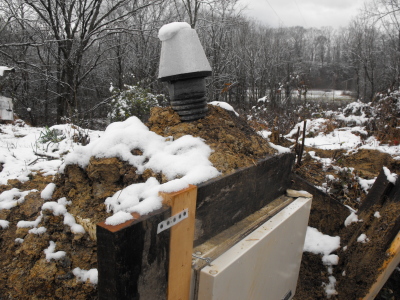 We had a slight problem with one of the
retaining walls for the refrigerator
root cellar. It seems like a sturdy metal bracket will be needed to
secure the wall to the side of the refrigerator.
We had a slight problem with one of the
retaining walls for the refrigerator
root cellar. It seems like a sturdy metal bracket will be needed to
secure the wall to the side of the refrigerator.
You might notice a faint circle of melted snow around the chimney output. This was more noticeable a couple of hours ago, which is a nice way to illustrate how warm the air must be that's coming out.
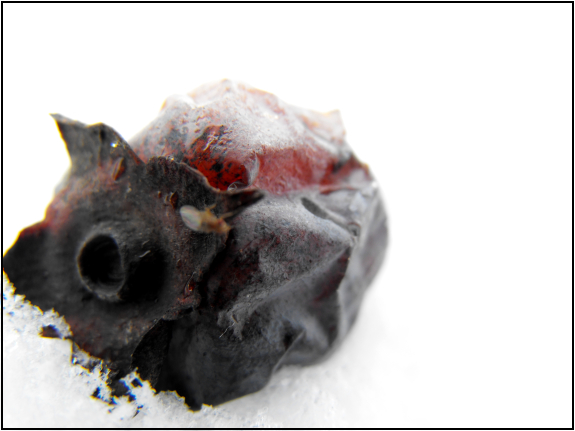
It's awfully nice to visit friends and family, but when you live in the
middle of nowhere without a tv or neighbors, being in the outside world
is a lot like going to Disneyland --- overwhelming. Once we cross
our moat and come home, it takes two warm cats, a heavy snow, and a pot
of soup boiling on the stove to return to farm mentality.
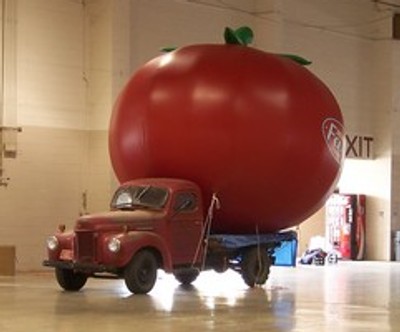 Yes...tomatoes are now considered carnivorous
predators who kill insects in order to "self fertilize". Botanists
have recently discovered for the first time how the stem of
tomatoes has sticky hairs that can capture and kill small insects and
then absorb the yummy nutrients when the bugs fall to the ground and
decay.
Yes...tomatoes are now considered carnivorous
predators who kill insects in order to "self fertilize". Botanists
have recently discovered for the first time how the stem of
tomatoes has sticky hairs that can capture and kill small insects and
then absorb the yummy nutrients when the bugs fall to the ground and
decay.
Some people think this trait developed in the wild in an effort to
boost the nutrient levels in poor soil areas, but most domestic
varieties have the same ability.
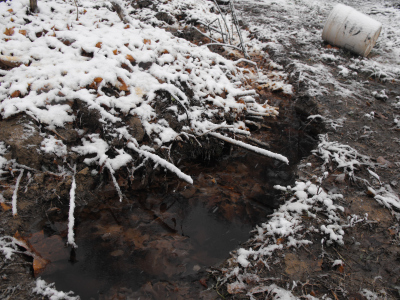 The
farm got an inch of rain while we were away --- perfect conditions to
test out our
new swales.
So far, I'm quite impressed by how they're working. The ditches
(swales) have filled up with water, but the surrounding ground seems
firmer and less waterlogged than usual.
The
farm got an inch of rain while we were away --- perfect conditions to
test out our
new swales.
So far, I'm quite impressed by how they're working. The ditches
(swales) have filled up with water, but the surrounding ground seems
firmer and less waterlogged than usual.
Unfortunately, I don't
think the swales are quite big enough since the soil downhill still has
some standing water. Next time I'm working in that area, I'll
decide whether to deepen the swales, add a berm, or just add more
swales.
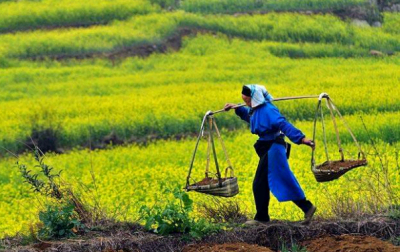 If you enjoyed my
series on traditional Central American farming practices, you'll love Farmers
of Forty Centuries
by F.H. King. Precisely 100 years ago, the American author
visited the eastern sections of China (along with Korea and
Japan). He documented his journey with
anecdotes, photos, and vivid prose like the following description of a
Cantonese house boat:
If you enjoyed my
series on traditional Central American farming practices, you'll love Farmers
of Forty Centuries
by F.H. King. Precisely 100 years ago, the American author
visited the eastern sections of China (along with Korea and
Japan). He documented his journey with
anecdotes, photos, and vivid prose like the following description of a
Cantonese house boat:
Sometimes husband and wife and many times the whole family were seen together when the craft was both home and business boat as well. Little children were gazing from most unexpected peek holes, or they toddled tethered from a waist belt at the end of as much rope as would arrest them above water, should they go overboard. And the cat was similarly tied. Through an overhanging latticed stern, too, hens craned their necks, longing for scenes they could not reach.
I'm excerpting the portions of the book which appeal to my organic gardening and permaculture leanings, but I highly recommend that you read the whole thing as an ultra-cheap Asian vacation. Although Farmers of Forty Centuries is currently back in print, you can still read the full text (minus the photos) for free on Project Gutenberg.
Check out our homemade chicken
waterers.
| This post is part of our Traditional Asian Farming lunchtime series.
Read all of the entries: |
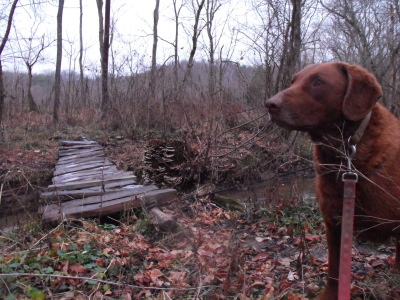 The foot bridge suffered
a fatal error recently when the weaker walnut support cracked and
sagged, making it unsafe for anyone to use.
The foot bridge suffered
a fatal error recently when the weaker walnut support cracked and
sagged, making it unsafe for anyone to use.
We've decided to not rebuild it and instead upgrade the stepping stone
crossing and install a zip line for when the water would be over the
new steps.

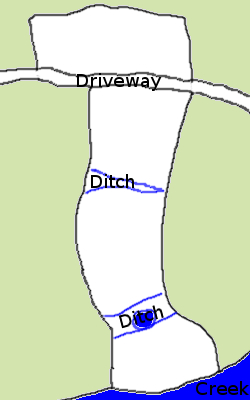 Our top choice for a pasture is the powerline
cut area down in the floodplain. The electric company chopped a
big swathe through the woods, and we can't let trees grow there, so we
might as well put it to use.
Our top choice for a pasture is the powerline
cut area down in the floodplain. The electric company chopped a
big swathe through the woods, and we can't let trees grow there, so we
might as well put it to use.
This weekend, I did some measuring and discovered that the open area
along the powerline is approximately one sixth of an acre. It
used to be farmed, long before we bought the land, so two ditches
bisect its width (and so does our driveway.) At the moment, I'm
thinking of using osage-orange
hedges to split the powerline cut into four paddocks along these
obvious dividing lines.
If we ever feel ready to have dairy animals, I've recently been
thinking our best bet would be miniature goats. They're short, so
fences don't have to be quite so intense, and they use less pasture per
animal so we might be able to fit in two does and a buck. With
four tiny paddocks, we'd be able to keep the buck separate and still
have room to rotate all the animals frequently to prevent overgrazing
and parasites. Of course, this is still very much in the dreaming
stages --- I expect our hedges to take anywhere from a year to five
years to be beefy enough to deter critters, and we still need to find
someone willing to milk when we're away from home!
 In the early twentieth century when Farmers of Forty Centuries
was written, Asia was immensely overcrowded compared to the United
States. Chinese farmers only had about two acres of agricultural
land to feed each person, compared to twenty acres per person in the
U.S. In addition, many parts of China had been farmed constantly
for four thousand years --- clearly, Chinese farmers weren't
subscribing to American tactics of using the land hard then moving on.
In the early twentieth century when Farmers of Forty Centuries
was written, Asia was immensely overcrowded compared to the United
States. Chinese farmers only had about two acres of agricultural
land to feed each person, compared to twenty acres per person in the
U.S. In addition, many parts of China had been farmed constantly
for four thousand years --- clearly, Chinese farmers weren't
subscribing to American tactics of using the land hard then moving on.
Although many of the traditional farming practices outlined in Farmers of Forty Centuries
have probably been replaced by mechanization and chemical fertilizers
in the last century, I
think we still have a lot to learn from the book. Urban
homesteaders will be enthralled by traditions that allow a person to be
fed on as little as a sixth of an acre of prime farmland. And
those of us watching the U.S. population explode will be equally
interested since we currently have only about three acres of farmland
to feed each American.
So how did Chinese farmers feed themselves on such small farms?
Read on.
| This post is part of our Traditional Asian Farming lunchtime series.
Read all of the entries: |
--- Errol, South Carolina
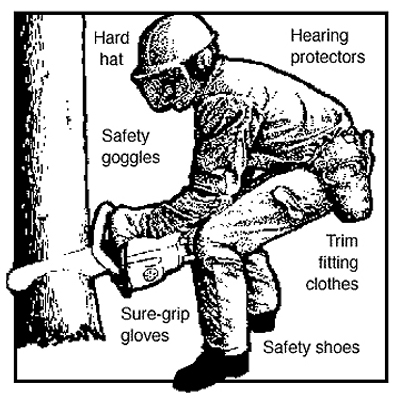 Thanks for the question.
Thanks for the question.
It didn't take me long to come up with an answer to this one. The Stihl
chainsaw would be my choice. You can get an attachment these days
that can turn any chainsaw into a heavy duty hedge trimmer, which would
be handy for clearing a new place. Firewood production would be my main motivation.
If you've got the time and talent a good chainsaw can also be used to make some impressive wood sculptures.
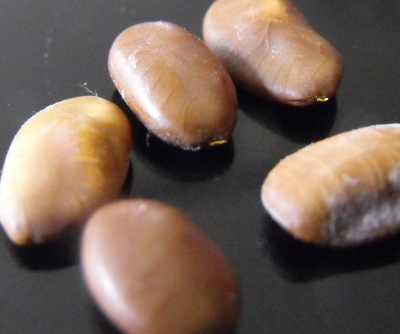 Most vegetable and annual flower seeds are
pretty easy to grow --- just throw them in the ground at something
close to the right depth at the right time of year and they sprout just
fine. When you start trying to plant tree, shrub, and perennial
herb seeds, though, propagation techniques often get a bit more
tricky. I always stumble when I'm told to scarify or stratify
seeds, but both techniques are actually quite easy, as I discovered
when I started looking up information about growing honey locusts
and persimmons from seed.
Most vegetable and annual flower seeds are
pretty easy to grow --- just throw them in the ground at something
close to the right depth at the right time of year and they sprout just
fine. When you start trying to plant tree, shrub, and perennial
herb seeds, though, propagation techniques often get a bit more
tricky. I always stumble when I'm told to scarify or stratify
seeds, but both techniques are actually quite easy, as I discovered
when I started looking up information about growing honey locusts
and persimmons from seed.
Persimmon seeds need to be stratified before they will germinate.
People try to make stratification more difficult than it actually is,
telling you to put the seeds in a pot of dirt or in a ziploc bag with a
wet paper towel and leave them in the fridge for a certain length of
time. In practice, I've discovered that native plants have
evolved to stratify quite nicely in the garden. Just plant the
seeds in the fall and they'll be exposed to plenty of cool temperatures
and will germinate as usual in the spring. I tried this with
persimmons a few years ago with good success and am trying again this
year.
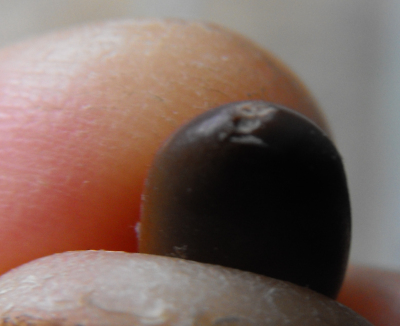 Honey locust seeds, on the other hand, need
scarification to germinate. The problem is that many seeds
evolved to be eaten by animals and to pass through the gut relatively
unharmed. Seeds need thick coatings to survive the stomach acids,
but these thick coatings are often impenetrable to water, meaning that
your seed won't sprout unless it's scarified. The natural way to
scarify seeds is to pass them through some animal's stomach and let the
acids break partway through the seed coating. Barring a handy
animal, people will drop the seeds in a vat of acid or hot water, or
will manually damage the seed coat (hopefully without damaging the seed
inside.) I tried to file my honey locust seeds with no luck, and
instead ended up snipping through the edge of the seed coat with
fingernail scissors. This is my first attempt at scarification,
so I'm very curious to see whether it works!
Honey locust seeds, on the other hand, need
scarification to germinate. The problem is that many seeds
evolved to be eaten by animals and to pass through the gut relatively
unharmed. Seeds need thick coatings to survive the stomach acids,
but these thick coatings are often impenetrable to water, meaning that
your seed won't sprout unless it's scarified. The natural way to
scarify seeds is to pass them through some animal's stomach and let the
acids break partway through the seed coating. Barring a handy
animal, people will drop the seeds in a vat of acid or hot water, or
will manually damage the seed coat (hopefully without damaging the seed
inside.) I tried to file my honey locust seeds with no luck, and
instead ended up snipping through the edge of the seed coat with
fingernail scissors. This is my first attempt at scarification,
so I'm very curious to see whether it works!
 Traditional Chinese
agriculture made extremely efficient use of space and time. One
trick they used was to apply heavy inputs of organic fertilizer,
allowing crop plants to be spaced very close together. (More on
the fertilizers tomorrow.)
Traditional Chinese
agriculture made extremely efficient use of space and time. One
trick they used was to apply heavy inputs of organic fertilizer,
allowing crop plants to be spaced very close together. (More on
the fertilizers tomorrow.)
Farmers also used
several techniques to tease two to four crops out of their farm each
year. They started most plants in seed beds so that space in the
main part of the farm was left open for an early season crop. A
typical rotation might include early season beans, followed by a grain
(such as the rice shown here). During the final month of a
grain's growth period, a third crop (like cotton) was often
interplanted so that the cotton could get a few weeks' head start on
the fall season. Those of us who are lax about our fall
gardens should take
heed!
As we all know, animals
require about five times as much land per calorie as vegetables do, so
it should come as no surprise that the traditional Chinese diet is very
low on meat. King noted that the primary meat animal was pigs,
which he explains convert plant matter to meat at the most efficient
rate.
And how about tree
crops? The best example of space-saving orcharding in the book
was the technique Japanese farmers used to raise pear trees. The
branches were trained to grow horizontally along an arbor just high
enough off the ground that farmers could walk underneath and easily
pick the fruit. Trees were spaced just twelve feet apart, and the
dense foliage shaded out most undergrowth. The technique sounds a
lot like espaliered
fruit trees to me.
| This post is part of our Traditional Asian Farming lunchtime series.
Read all of the entries: |
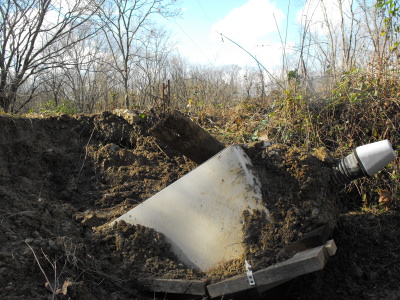 The refrigerator
root cellar suffered a set back last night during a heavy down pour.
The refrigerator
root cellar suffered a set back last night during a heavy down pour.
It should only take a few hours to dig back out, and the new plan is
to add a small roof like the one on our home
made firewood shed to prevent this from happening again.
Two and a
half inches of rain following a week of frozen ground means flood!
I'm working on my video
skills, so hopefully this one will be more
entertaining than my
previous flood video.
If you hate videos
(Mom), here's a photo of a snail I caught climbing a
wingstem stalk to escape from the rising waters. Also, feel free
to check out our newest feature --- a link to the week's top three most
visited articles at the bottom of the sidebar. If you go read all
three, it's almost like being popular!
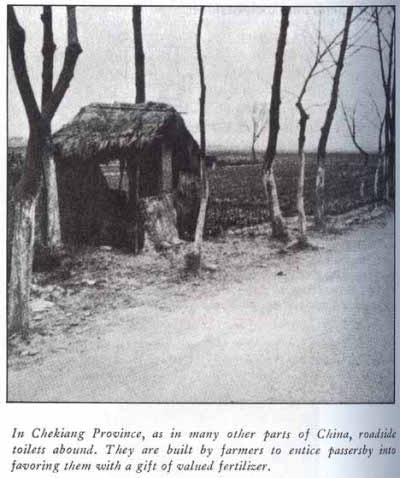 I have to admit that my
primary goal in reading Farmers
of Forty Centuries
was to discover whether farmers really put outhouses along public
roads, hoping to trap travelers into depositing their wastes
therein. The book gave me a resounding yes, and noted that
contractors also paid for the privilege of removing human waste from
cities so that they could sell the precious substance to farmers.
Humanure was often diluted with water and applied directly to fields or
dried and then applied in a powder form.
I have to admit that my
primary goal in reading Farmers
of Forty Centuries
was to discover whether farmers really put outhouses along public
roads, hoping to trap travelers into depositing their wastes
therein. The book gave me a resounding yes, and noted that
contractors also paid for the privilege of removing human waste from
cities so that they could sell the precious substance to farmers.
Humanure was often diluted with water and applied directly to fields or
dried and then applied in a powder form.
Of course, it took a lot
more than humanure to maintain the fertility of fields for thousands of
years. King saw farmers building huge compost piles, planting
nitrogen fixing plants (especially clovers) as a green manure, and
cutting plants from the hillside and grave mounds to apply to the soil
or to add to their compost piles. Just
like in Central America, 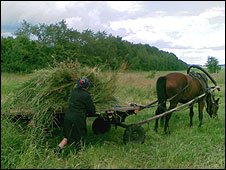 high fertility silt was
excavated from canals and applied to fields, and King noted that the
snails in the canal mud were also important in the fertilizing
campaign. Farmers scavenged animal wastes from the roadsides and
carefully husbanded any wastes from their own livestock, and they also
drained fish ponds at intervals so that they could scoop up the high
quality mud on the pond floor. The addition of ashes from their
cooking fires and all plant residues from their fields rounded out
their organic matter.
high fertility silt was
excavated from canals and applied to fields, and King noted that the
snails in the canal mud were also important in the fertilizing
campaign. Farmers scavenged animal wastes from the roadsides and
carefully husbanded any wastes from their own livestock, and they also
drained fish ponds at intervals so that they could scoop up the high
quality mud on the pond floor. The addition of ashes from their
cooking fires and all plant residues from their fields rounded out
their organic matter.
| This post is part of our Traditional Asian Farming lunchtime series.
Read all of the entries: |
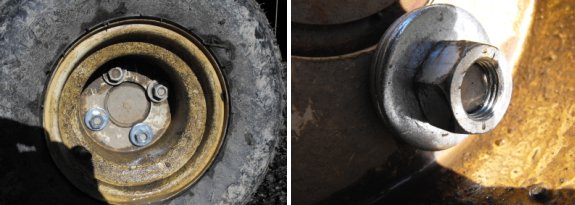
What happens when you don't tighten down the lug nuts on your golf cart
and drive for several weeks as they slowly loosen? The lug nut threads
get worn, creating a problem that requires a replacement.
A trip to the local hardware store proved the special nuts were not a
common item, but a regular one was that had the same thread ratio, and
to compensate for the lack of shoulder I just added a beefy washer.
We've been driving it this way for a couple of months now with no
problem.
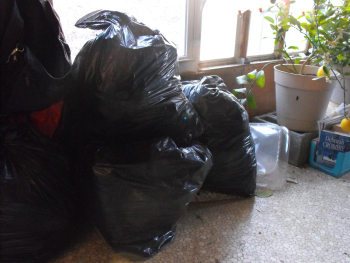 I've
always been fond of Boxing Day...even though few people have actually
heard of it in the U.S. In the United Kingdom, Canada, Australia,
and New Zealand, the day after Christmas was traditionally a time for
people who could afford it to give a box of gifts to their poorer
neighbors. Granted, Boxing Day is now more akin to our Black
Friday, but I like the original holiday I read about in British
children's books during my formative years.
I've
always been fond of Boxing Day...even though few people have actually
heard of it in the U.S. In the United Kingdom, Canada, Australia,
and New Zealand, the day after Christmas was traditionally a time for
people who could afford it to give a box of gifts to their poorer
neighbors. Granted, Boxing Day is now more akin to our Black
Friday, but I like the original holiday I read about in British
children's books during my formative years.
Until I moved to the
farm, I was a bit of a vagrant, moving every year. The yearly
move gave me a great opportunity to go through all of my possessions
and cull out items that I really didn't feel like carrying up and down
several flights of stairs, donating them to Goodwill. Now that
we've been living on the farm for over three years, lack of a yearly
move has led to far too much clutter.
This week, Mark and I
started on our own version of Boxing Day. We each went through
our clothes with a fine-tooth comb, culling about half of them to be
given away. The result is immediate gratification ---
space! Next on my "Boxing Day" agenda will be culling my books,
the only other items that seem to build up in my living space.
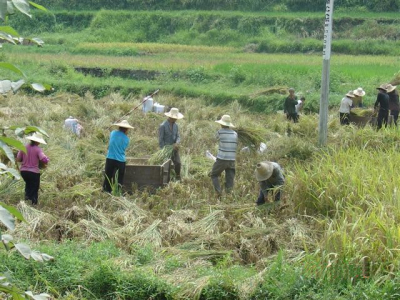 In addition to lacking space,
China has a serious shortage of wood. Even a hundred years ago,
King noted that trees were scarce and small, and even those trees were
heavily utilized by cutting the lower limbs for firewood.
In addition to lacking space,
China has a serious shortage of wood. Even a hundred years ago,
King noted that trees were scarce and small, and even those trees were
heavily utilized by cutting the lower limbs for firewood.
As a result of the wood
shortage, most buildings were traditionally made out of straw and
clay. Although the straw and clay tended to need frequent
replenishing, the old building materials were perfect for throwing in
the compost pit.
Farmers were also very
good at utilizing other types of plants for fuel. Woody vegetable
stems (especially rice straw) were frequently burned. Although I
approve of making full use of the resources at hand, King's description
of the cooking fire requiring one person to constantly feed it small
bits of straw sounds like a bit too much work.
Otherwise, King made the
Chinese traditional agriculture system look so rosy that
I find it hard to remember that, a century later, farming looks a lot
different. If you're interested in what's happened in the last
hundred years, you should check out the overview
on Wikipedia.
| This post is part of our Traditional Asian Farming lunchtime series.
Read all of the entries: |
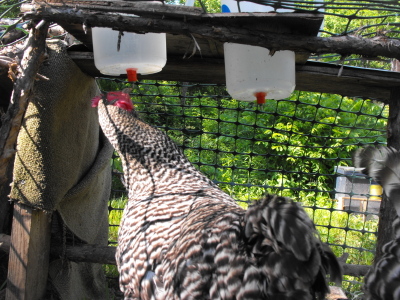 A simple system that works well for our automatic chicken waterers
is to have at least 2 available for each group, that way if you forget
and leave one out overnight when it freezes you'll have the back up to
set out while the frozen one takes the day off by warming back up.
A simple system that works well for our automatic chicken waterers
is to have at least 2 available for each group, that way if you forget
and leave one out overnight when it freezes you'll have the back up to
set out while the frozen one takes the day off by warming back up.
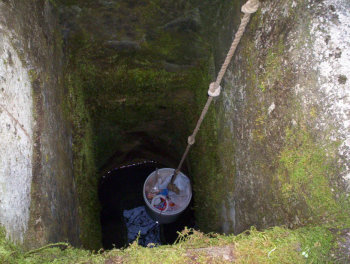 Although people used to live on our farm
during the Depression, the farm's only drinking water supply is a
shallow, hand dug well that tested positive for coliform
bacteria. Granted, many people drink from shallow wells and
springs just like this around here. You build up a tolerance and
tend to do just fine, but if you give water to unsuspecting visitors,
they get sick.
Although people used to live on our farm
during the Depression, the farm's only drinking water supply is a
shallow, hand dug well that tested positive for coliform
bacteria. Granted, many people drink from shallow wells and
springs just like this around here. You build up a tolerance and
tend to do just fine, but if you give water to unsuspecting visitors,
they get sick.
To avoid this problem, we spent our first year or two lugging drinking
water back to the farm. My mom would rinse out empty milk jugs
and save them for me, then we'd fill them up at her house when we went
to visit. Other times, we'd fill up our milk jugs at various
other friends' houses closer to the farm. Sometimes, we were able
to haul the jugs of water back to the trailer in our four wheel drive
truck, but a lot of the time the truck wasn't working and we'd just
carry them in --- it's not too hard to haul a jug of water in each hand
while walking Lucy in the morning.
Water feels more precious when the supply is limited. We cooked
and drank the special water, going through about a gallon a day between
us. For everything else, we used creek water, treated with some
bleach when we did dishes, but plain for other tasks.
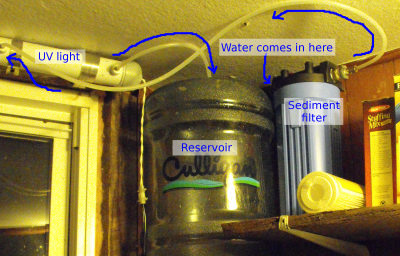 Then we splurged on our water
filtration system and were blessed with unlimited, safe drinking
water. I felt like we'd moved from a third world country to a
second world country!
Then we splurged on our water
filtration system and were blessed with unlimited, safe drinking
water. I felt like we'd moved from a third world country to a
second world country!
The only flaw is that we still haven't quite gotten our water line
all the way buried since my wrists can't take much heavy digging and I
tend to set Mark on tasks that seem more important. So this week
we fell halfway back to our third world country. I dragged all of
the old milk jugs out of the barn, rinsed them out, and filled them up
with our treated water. By Friday, the freeze set in and we
started dipping into stored water.
It's funny to read on other peoples' blogs about disaster preparedness
--- people filling up empty milk jugs just in case the world comes to
an end or a heavy storm knocks out their power for days on end.
It doesn't really feel like a disaster to be pumping our drinking water
during thaws and drinking out of jugs during cold snaps. I guess
it's all a matter of perspective....
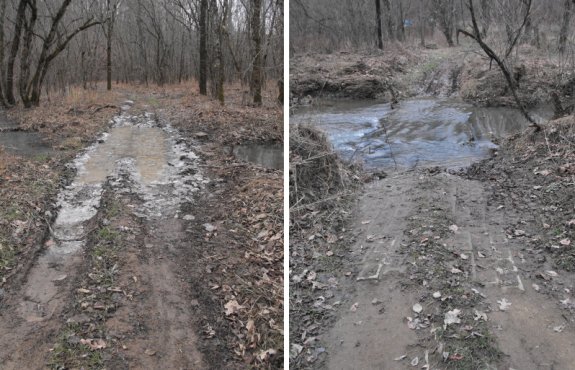
These past few days have been a real test for the new mud
traction golf cart tires. I thought the frozen ruts might create
too much of a challenge, but the ice isn't quite frozen through all the
way and seems to break easily with a dramatic crashing sound that sends
my imagination racing to an Arctic exploration story I once read.
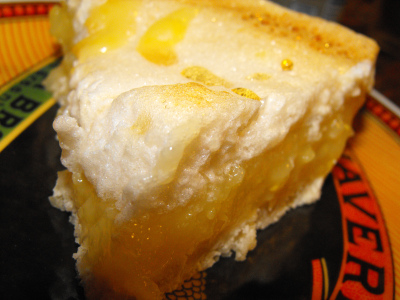 We
love our dwarf Meyer lemon. We got it as a tiny tree two years
ago and ate
our first four lemons last February. We just got three
more lemons that turned into the most delicious lemon meringue pie, and
the tree still has four half-grown lemons and an explosion of flowers
on its branches.
We
love our dwarf Meyer lemon. We got it as a tiny tree two years
ago and ate
our first four lemons last February. We just got three
more lemons that turned into the most delicious lemon meringue pie, and
the tree still has four half-grown lemons and an explosion of flowers
on its branches.We've now met four other people who have dwarf Meyer lemons, and the reports are varied. Our neighbor has a several year old tree that had 91 lemons on it last year:

On the other hand, my
father's lemon tree is a year old with no sign of blooms or
fruits. Another friend's lemon tree looks even more puny.
What's going on?
I'm far from an expert
on dwarf Meyer lemons, but I'm starting to think that the trees require
heavy feeding and big pots. Our lemon tree is in a five gallon
pot that I filled with stump dirt, topped off later with worm castings,
and now fertilize regularly with compost tea from the worm bin.
My neighbor's amazing lemon tree is in an even bigger pot and he feeds
it Miracle Grow. On the other hand, the less happy trees I've
seen have all been in smaller pots. Remember, creating lemons
takes a lot of energy, so your tree needs plenty of nitrogen.
My advice, for what it's
worth --- transplant your lemon into a big pot and feed it, feed it,
feed it! Under the right conditions, dwarf Meyer lemons are a
great source of citrus for those in cold climates who want to grow
their own as a houseplant.
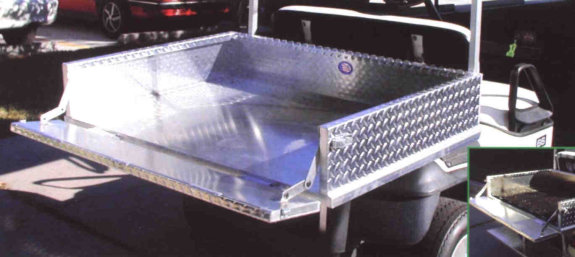
I think this is the design I've settled on for increasing the load
capacity of the golf cart. You can order the shiny
new metal version for about 350 dollars, or maybe a sheet of
plywood with a few 2x6's could become a nice low budget home made dump
box for your golf cart. Soon this project will move from my imagination
to the Wetknee drawing board once the storage
building project gets wrapped up.
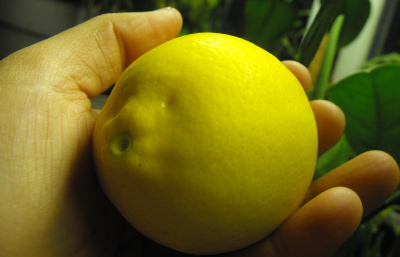 My
post yesterday about care
of your Meyer lemon tree got long, so I didn't have
room to fit in what I've learned about cooking with the fruits.
Since Meyer lemons are actually a hybrid between a true lemon and an
orange, their flesh is a bit sweeter than the lemons you'd buy in the
store --- just sweet enough that sour-lovers like me can eat them
raw. When cooking with Meyer lemons, I tend to lower the amount
of sugar in the recipe a bit so that we're not overwhelmed with
sweetness.
My
post yesterday about care
of your Meyer lemon tree got long, so I didn't have
room to fit in what I've learned about cooking with the fruits.
Since Meyer lemons are actually a hybrid between a true lemon and an
orange, their flesh is a bit sweeter than the lemons you'd buy in the
store --- just sweet enough that sour-lovers like me can eat them
raw. When cooking with Meyer lemons, I tend to lower the amount
of sugar in the recipe a bit so that we're not overwhelmed with
sweetness.
I've also noticed that
the zest (grated rind) isn't as tangy as that on a true lemon.
Here I tend to cheat and throw in a bit of extra zest from a
storebought lemon. On the other hand, Martha Stewart will
tell you that the white part of a Meyer lemon isn't bitter, so you can
just cut up the whole lemon and put it in various dishes --- I'll have
to give that a try!
If you want to learn
more about the Meyer lemon, I recommend this
NPR article.
Did you know they've been grown as container plants in China for over a
century?
 I was sucked into Teaming with Microbes by
Jeff Lowenfels and Wayne Lewis this weekend. Teaming with Microbes took
the information from my Living
Soil lunchtime series and turned it into what felt like a fast-paced action novel,
complete with stunning photos of the characters.
I was sucked into Teaming with Microbes by
Jeff Lowenfels and Wayne Lewis this weekend. Teaming with Microbes took
the information from my Living
Soil lunchtime series and turned it into what felt like a fast-paced action novel,
complete with stunning photos of the characters.
As you probably remember, a healthy soil food web equates to a healthy
organic garden. If you have the right critters in your soil,
you'll have better nutrient retention, better soil structure, and
better defense against diseases.
But Lowenfels and Lewis took the story one step further, explaining
that not every soil food web is created equally. Nor will one
type of food web make all plants happy. The key is to come up
with the right fungi to bacteria ratio for each garden.
| This post is part of our Teaming With Microbes lunchtime series.
Read all of the entries: |
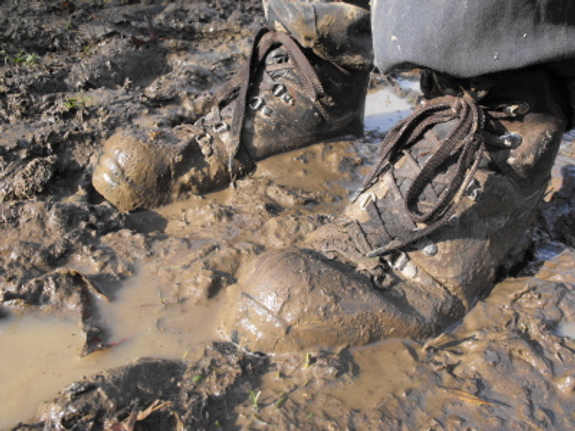
I'll take
warm and muddy over cold and frozen any day.
Mark Twain: “Buy land. They’ve stopped making it.”
Seasteaders: “Production Resuming.”
 Do you want to go back to the
land without being under the sway of the federal government? If
so, the Seasteading Institute
suggests you should instead go back to the water. They envision
intentional homesteading colonies constructed on floating platforms in
international waters. Out there on the sea frontier, you can do
whatever you want since no nations' laws apply.
Do you want to go back to the
land without being under the sway of the federal government? If
so, the Seasteading Institute
suggests you should instead go back to the water. They envision
intentional homesteading colonies constructed on floating platforms in
international waters. Out there on the sea frontier, you can do
whatever you want since no nations' laws apply.
The nonprofit is founded
by libertarians, and they bill seasteading as
a method of testing out new political systems. I can also see the
appeal of building your own nation from an entirely nonpolitical point
of view --- homesteaders everywhere wrestle with restrictive building
codes that don't allow them to build strawbale houses or composting
toilets. Wouldn't it be nice to be able to choose environmentally
sustainable options without jumping through months of hoops?
Mark's response was,
"One word: pirates." (Though
the Seasteading Institute thinks that pirates wouldn't be a big deal.)
And, granted, I'm far too attached to my hills to leave the land for
the sea. Still, I thought you all might be interested.
After all, the first colony is planned to go live in 2015.
 What is a fungi to bacteria ratio? The fungi to bacteria ratio
is simply the mass of fungi in the soil compared to the mass of
bacteria in the soil. In most cases, all you really need to know
is whether the soil is dominated by fungi, dominated by bacteria, or
has an even proportion of both.
What is a fungi to bacteria ratio? The fungi to bacteria ratio
is simply the mass of fungi in the soil compared to the mass of
bacteria in the soil. In most cases, all you really need to know
is whether the soil is dominated by fungi, dominated by bacteria, or
has an even proportion of both.
In nature, disturbed soils like those after a mudslide or in your
recently tilled garden have a strong bacterial dominance. As the
soil is left alone for a while, fungi start to move in until habitats
like prairies or your lawn have a relatively even proportion of fungi
and bacteria in residence. Later, as shrubs and trees take over,
the fungi in the soil build up even more so that forest soils are
strongly fungi dominated.
Scientists have started to look at the fungi to bacteria ratio
preferred by garden plants as well. They discovered that carrots,
lettuce, and crucifers enjoy strongly bacteria dominated soils while
tomatoes, corn, and wheat like soils that are closer to evenly matched
(though still leaning a bit toward bacteria.) On the other hand,
most perennials, shrubs, and trees like the soil to be full of fungi at
ratios from 10:1 to 50:1.
Clearly, folks like me who have been treating our trees just like our
lettuce beds need to stop!
| This post is part of our Teaming With Microbes lunchtime series.
Read all of the entries: |
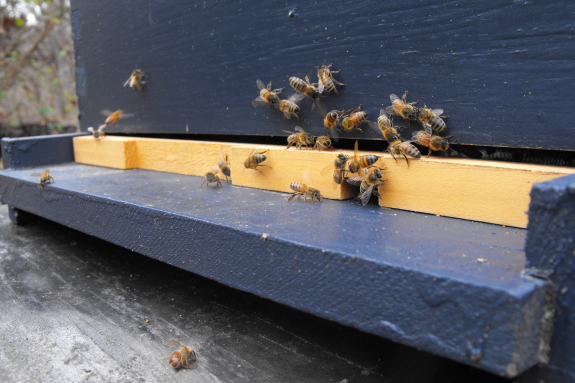
Anna installed these entrance reducers in all
three hives today. Without this you run the risk of a mouse making
its way into your hive and making a sweet feast of all that delicious
honey.
I took advantage of
temperatures above 50 to check on our hives Tuesday. We've been feeding
sugar water pretty much continuously for the last six weeks,
stopping only when winter set in and started freezing our
feeders. My hive check showed that the girls have been
dehydrating the sugar water and packing it away very nicely --- we're
now up to 46, 64, and 69 pounds of honey in our three hives, which
should carry them all through the winter. I'm a little concerned
at the apparent lack of pollen in the hives, but hopefully our early
blooming hazels will provide pollen just as brood-rearing begins in the
spring.
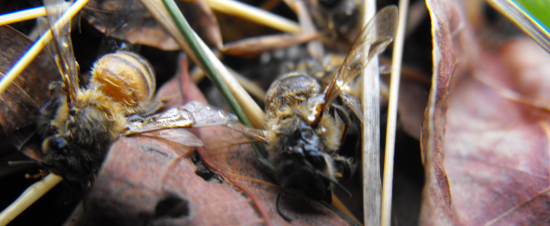
Outside the hive, dozens
of dead bees litter the ground. Although it looks like a massacre
took place, this is perfectly normal. Every hive
cuts down its numbers in early winter, first kicking out the drones
then letting the older worker bees die as well. I guess that's
one way to control your population so you don't run out of food!
 Why
do some plants like fungi around their roots while others like
bacteria? The answer takes us into the realm of chemistry...hang
in there.
Why
do some plants like fungi around their roots while others like
bacteria? The answer takes us into the realm of chemistry...hang
in there.
Most soil bacteria
secrete a slime that holds them to soil particles so
that the tiny microorganisms don't wash away. This slime tends to
be alkaline, so as bacteria build up, the soil pH rises above 7.
Meanwhile, the type of
nitrogen in the soil changes. Decomposers
in the soil excrete ammonium as a waste product, but when there are
lots of bacteria around, the bacteria convert the ammonium into nitrate.
On the other hand, soil
fungi secrete acids that they use to break down
organic matter, making it easier to digest. The acids in the soil
make the environment more difficult for bacteria to inhabit, so most of
the nitrogen in the soil stays as ammonium rather than being converted
to nitrate.
As every gardener knows,
plants care about pH. What many
gardeners don't realize is that plants also care about the form of
nitrogen they take up. Vegetables, annuals, and grasses tend to
prefer nitrate, while trees, shrubs, and perennials prefer
ammonium. Now we know why lettuce is going to throw a hissy fit
if the soil is full of fungi.
| This post is part of our Teaming With Microbes lunchtime series.
Read all of the entries: |
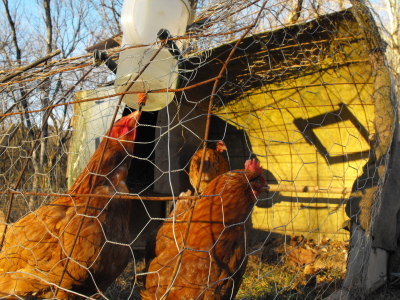 This chicken
tractor is slated for upgrade in early 2010. I got a bit carried
away with the construction and ended up making it too heavy, which
creates a problem when dragging it to a new location.
This chicken
tractor is slated for upgrade in early 2010. I got a bit carried
away with the construction and ended up making it too heavy, which
creates a problem when dragging it to a new location.
The other problem is an issue of access. It really needs another door
close to the ground. That way if they escape you can coax them back in
easily with a bribe of chicken feed.
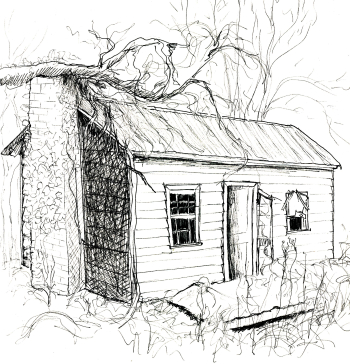 The
old house at the edge of the yard has been on its way out ever since I
bought the property. It was built with no foundation and no
structural elements except for thin walls, and yet it stood for three
quarters of a century. By the time I arrived on the property, it
had developed a bit of a lean and the porch and one room had collapsed,
but we probably could have shored it up. Mark wasn't in the
picture yet, though, and I knew nothing, so I commenced to tear it
down. Here's an animation showing me tearing down the second of
the four rooms:
The
old house at the edge of the yard has been on its way out ever since I
bought the property. It was built with no foundation and no
structural elements except for thin walls, and yet it stood for three
quarters of a century. By the time I arrived on the property, it
had developed a bit of a lean and the porch and one room had collapsed,
but we probably could have shored it up. Mark wasn't in the
picture yet, though, and I knew nothing, so I commenced to tear it
down. Here's an animation showing me tearing down the second of
the four rooms:
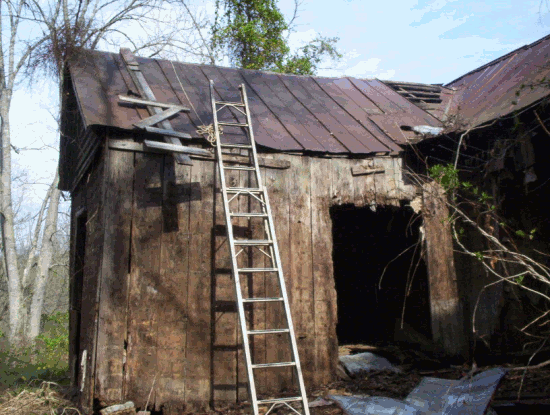
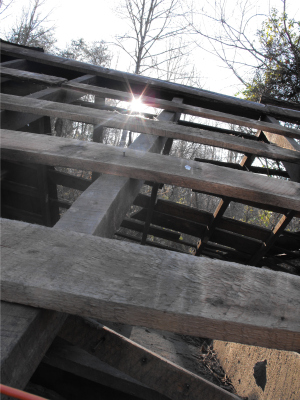 By
the time Mark stepped in and stopped me, I had torn the house down to
the original two rooms, then had ripped half the walls off what
remained. What little structure the house once had was long gone,
but the house stood for another year or two anyway. Finally, it
developed such a major lean that we were afraid it would fall on Lucy
in the night, so we yanked it down with the hand
winch, but never managed to take the time to disassemble it.
By
the time Mark stepped in and stopped me, I had torn the house down to
the original two rooms, then had ripped half the walls off what
remained. What little structure the house once had was long gone,
but the house stood for another year or two anyway. Finally, it
developed such a major lean that we were afraid it would fall on Lucy
in the night, so we yanked it down with the hand
winch, but never managed to take the time to disassemble it.
This week, I've finally put house demolition back on the to do
list. Mark's got the homemade
storage building
walls nearly complete, and then he'll be needing a roof. I figure
we can save about $200 by reusing the old tin, and that doesn't even
take into consideration the thick rafters that are already cut to just
the right length. Finally, the old house is worth taking apart.
I have to admit my ulterior motive, though. The old house sits on
some of the richest soil in our yard, ground that I've been eying for
years. By taking the house apart, I'll have yet more garden space!
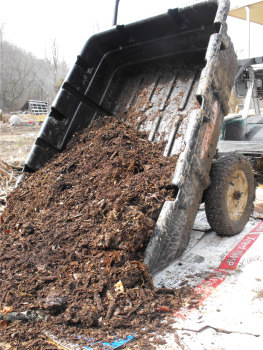 So
how do we build vegetable gardens with soil dominated by bacteria while
creating fungi-dominated soil around our trees? The first step is
to start being more sophisticated about our mulch choices.
So
how do we build vegetable gardens with soil dominated by bacteria while
creating fungi-dominated soil around our trees? The first step is
to start being more sophisticated about our mulch choices.
Bacteria are good at
breaking down what composters like to call
"greens" --- grass clippings, food scraps, and even straw (since the
grain was cut while it was still growing and full of sugars.)
Bacteria also thrive on easy to digest manures. On the other
hand, fungi shine when given "browns" --- fallen leaves, wood chips,
and anything else full
of lignin and hard for most other organisms to
digest.
The consistency and
application method of the mulch matters too.
Wet, finely ground mulch supports bacteria, even if the mulch consists
of fallen leaves. On the other hand, dry mulch in big chunks will
encourage fungi. Any mulch that is worked into the soil will feed
bacteria first, while mulch placed on the soil surface will feed fungi.
So an optimal mulch for
a vegetable or annual flower garden would
probably consist of finely chopped, wet grass clippings. Under
our trees, the best mulch would be big chunks of leaves or wood chips.
| This post is part of our Teaming With Microbes lunchtime series.
Read all of the entries: |
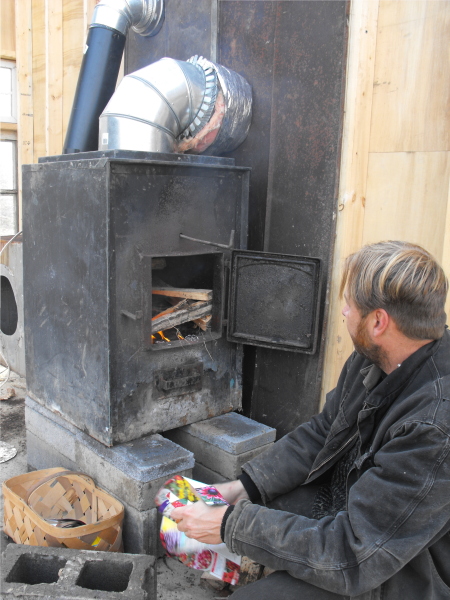
Fire.
We now have the exterior
wood burning stove operating in the half finished storage
building. This must be what it felt like when early cave men
figured out that keeping your woman warm equals keeping her happy.
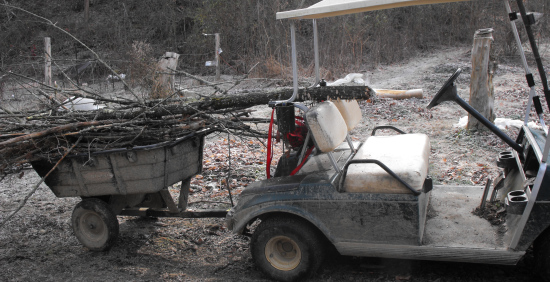
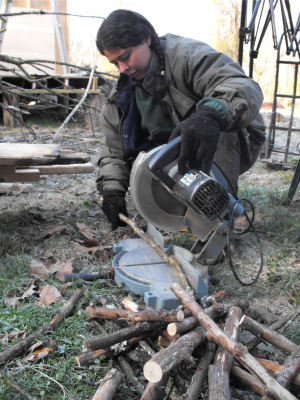 Since Mark
now has our wood stove up and running, I figured it was high time
to gather some kindling. The windy days last week knocked down a
lot of dead, dry branches out of trees in the floodplain, and it only
took a few minutes to pick up a heavy hauler load.
Since Mark
now has our wood stove up and running, I figured it was high time
to gather some kindling. The windy days last week knocked down a
lot of dead, dry branches out of trees in the floodplain, and it only
took a few minutes to pick up a heavy hauler load.
Last winter when the chainsaw wasn't working, we discovered that the
miter saw makes short work of small and medium-sized branches.
First, I broke all of the small branches over my knee, then I sawed
through the larger branches.
I was a bit shocked at how small one heavy hauler load of kindling
becomes once sawn to size --- the resulting pile was only about knee
high. That should be enough to start a week's worth of fires,
though. Warmth sure does make me happy!
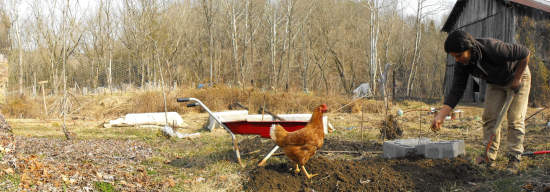
Teaming
with Microbes
made it clear that we have to make some major tweaks to our mulching
and fertilizing campaign. The horse manure and grass
clippings we
apply to our vegetable garden beds are perfect, but next year we should
shred our tree leaves much more before applying them as a winter mulch.
On the other hand, I'm
starting to rethink whether I should have
applied
horse manure to our fruit trees. It sounds like heavy
mulches of rotting wood chips or leaves are more likely to lead to the
fungi dominated soil communities these trees prefer. At least we
didn't fall into the trap of trying to grow grass under our fruit trees
--- a big no-no since grass prefers bacteria while trees prefer fungi.
| This post is part of our Teaming With Microbes lunchtime series.
Read all of the entries: |
 These new peel and stick solar panels are more
efficient than the fragile glass panels and cost about 300 bucks less.
This new design allows for more robust applications, such as on the
roof of a golf cart without the fear of your expensive panel breaking.
Having the sun constantly charging your batteries prevents the sulfates
from building up and extends the life of the battery bank by a minimum
of 25%.
These new peel and stick solar panels are more
efficient than the fragile glass panels and cost about 300 bucks less.
This new design allows for more robust applications, such as on the
roof of a golf cart without the fear of your expensive panel breaking.
Having the sun constantly charging your batteries prevents the sulfates
from building up and extends the life of the battery bank by a minimum
of 25%.
Since a golf
cart is sometimes considered an electric car by the IRS you can
deduct a nice 30% of your solar investment and you may even qualify for
a few hundred bucks per year as a battery credit. These kits usually
cost about 1600 dollars, weigh about 4 pounds and take about 15 minutes
to install.
Add an inverter and it can double as an emergency back up power system
for your home if you can manage to park it close enough to reach an
extension cord to.
Anna's brother and site admin Joey filling in for my sister -- The blizzard of '09 has cut off power and snowed Anna in. With wood heat she'll be ok. I will try to get her on the phone for a farm update later.
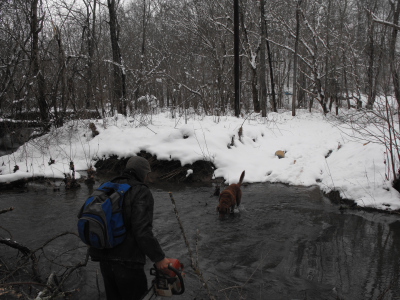 Our
power and phone are out, and look like they'll stay out for the near
future. Honestly, the hardest thing for me about life without the
grid is an inability to blog. We've made it to town for a quick check in so that I can upload the masses of posts I've written while off the grid --- I've set them to autopost over the next couple of days so that you'll have something to read while we're out of touch.
Our
power and phone are out, and look like they'll stay out for the near
future. Honestly, the hardest thing for me about life without the
grid is an inability to blog. We've made it to town for a quick check in so that I can upload the masses of posts I've written while off the grid --- I've set them to autopost over the next couple of days so that you'll have something to read while we're out of touch.
Don't feel rejected if
your comments don't show up until I return to the internet and if I
don't respond to your emails. We're thinking of you, in between
our efforts to stay warm and dry. Meanwhile, Happy Winter
Solstice! Merry Christmas! And, if the electric company
doesn't bring us back to the mainstream by then, Happy New Year!
Many thanks also to Joey for letting you know we're alive and well.
Can't live without us? Download our microbusiness ebook and have some fun reading while waiting for us to come back.
This post is part of our Two Weeks Without Electricity series.
Read all of the entries:
|
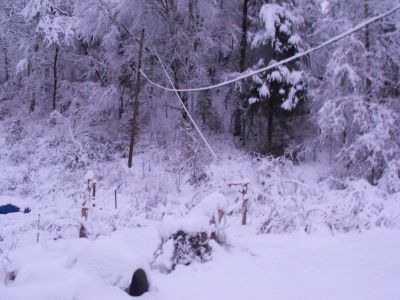 The
trees started splintering before sunset on Friday. Heavy snow
weighed down their limbs and kept falling, heaping up four inches
deep. By dark, the wet snow took down an electric line somewhere,
and suddenly the trailer powered down. Off went the furnace fan,
the computers, the fridge. I called the phone company and was
informed that power is off all over the county and that they expect it
back on by Sunday at midnight.
The
trees started splintering before sunset on Friday. Heavy snow
weighed down their limbs and kept falling, heaping up four inches
deep. By dark, the wet snow took down an electric line somewhere,
and suddenly the trailer powered down. Off went the furnace fan,
the computers, the fridge. I called the phone company and was
informed that power is off all over the county and that they expect it
back on by Sunday at midnight.
The snow kept
coming. When we went to bed, it was already six inches deep, and
all night gunshot-like cracks heralded trees crashing down. I
slept fitfully and was out at dawn to assess the damage.
During power outages,
I'm constantly expecting a miracle --- the lights will flicker, the
fridge will hum, and we'll be powered again. At first light on
Saturday, I discovered that wasn't going to happen anytime soon.
Our powerline was down straight up the floodplain, across the garden,
and then up the powerline cut going the other way. I called my
mom to share the excitement, hung up, and then picked the phone back
up. It was dead.
I
don't want to overwhelm you with the whole story at once, so stay tuned
for part II soon. Until then, feel free to check out our
ebook about starting your own business and quitting your job.
This post is part of our Two Weeks Without Electricity series.
Read all of the entries:
|
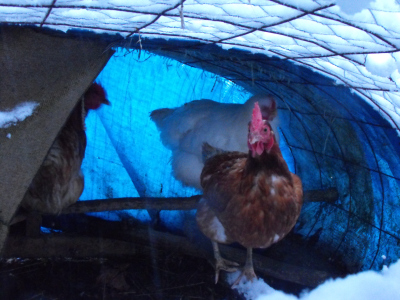 Our
first full day without power brought us back to basics: animals, water,
food, and shelter. The animals, luckily, weren't too hard.
Huckleberry and Strider came bounding up to the trailer through snow
over their heads (nearly a foot deep now, but finally slacking off) and
Lucy pranced and played in the drifts.
Our
first full day without power brought us back to basics: animals, water,
food, and shelter. The animals, luckily, weren't too hard.
Huckleberry and Strider came bounding up to the trailer through snow
over their heads (nearly a foot deep now, but finally slacking off) and
Lucy pranced and played in the drifts.
The chicken tractors
were completely covered, and one had half-collapsed under the weight of
the snow. I brushed the tops clear and saw hungry hens eager for
their breakfast...once I'd shoveled out the tractor so they wouldn't
get their feet wet.
Without electricity, the
fan on our exterior wood furnace doesn't run, which means that most of
that heat dissipates into the great outdoors. Mark first rigged
an ingenious setup using a DC fan and the golf cart's battery banks,
but the plastic fan quickly melted out of whack and stopped running.
At this point, I gave up and curled myself under a sleeping bag on the
sofa with Huckleberry and a book. But Mark wasn't deterred.
He dusted off the generator, and soon we were back in business!
Lights, power, action! Heat! Even electricity to top off
the cold level in our fridge and freezer and keep our food safe.
Luckily, we had drinking water stored up, but food was going to be
difficult since we cook on an electric stove. It took most of the
next day for me to figure out how to cook in and on the wood stove,
ending up with food that wasn't charred at one end and cold at the
other. But at least we had the basics we need to keep the farm
rolling along.
Stay tuned for part III soon. Meanwhile, feel free to check out our ebook about starting your own business and quitting your job.
This post is part of our Two Weeks Without Electricity series.
Read all of the entries:
|
 We bought the Champion 3000 watt generator about a year ago for back up power. I took it out of the box, made sure it was all there, and
installed the wheels and handle and pretty much forgot about it till
this past Friday when our power went out.
We bought the Champion 3000 watt generator about a year ago for back up power. I took it out of the box, made sure it was all there, and
installed the wheels and handle and pretty much forgot about it till
this past Friday when our power went out.
It was a great relief to feel its gas-powered throaty engine come to
life. We only have about 4 gallons of fuel on hand, so we decided to
ration our generator time to a few hours in the evenings. This way we
can alternate between the freezer and refrigerator, giving them each
about an hour of cooling off time, charge our laptop batteries, and
power the blower fans that send heat from our exterior wood burning
stove to the inner sanctum of the trailer. The new stove configuration
is able to keep the back room heated during the night without the fan
as long as we keep it fed with fresh firewood.
We've got a bit of kerosene, and nearly a full tank of propane as back
up for heating and cooking, but I don't think we'll need it if we're
able to get out tomorrow and top off our generator fuel.
I was most impressed with how easy this generator started. I barely
have to pull on the rope and it springs to attention.
I'm not sure when we can expect to have our electricity fixed, so I
guess I'll be expecting nothing and gearing up to be ready for anything.
This post is part of our Two Weeks Without Electricity series.
Read all of the entries:
|

By Saturday afternoon,
the snow was a bit mushy on the bottom layers. Trees began to
shake themselves like wet dogs, tossing off their mantle of wet snow
and turning back up to face the sky. The cracks of falling limbs
and trees slowed and finally stopped, and Sunday morning I decided it
was time to explore our world.
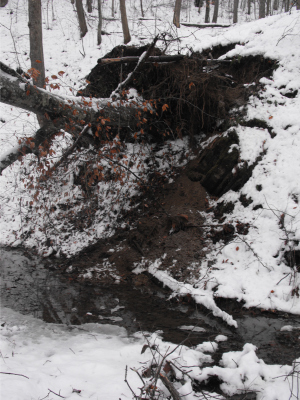 I
borrowed Mark's knee-high over-boots, put on damp jeans over dry fleece
pants, and headed out to see what the outside world looked like.
I had to cross the downed power line, which I had skittishly steered
clear of for the last day even though it was coated in snow and Lucy,
Huckleberry, and a deer had all trotted across with no problems.
This time I was determined, though. So I tucked Lucy's leash over
her back and took a running leap across the white snake of wire hidden
under the snow.
I
borrowed Mark's knee-high over-boots, put on damp jeans over dry fleece
pants, and headed out to see what the outside world looked like.
I had to cross the downed power line, which I had skittishly steered
clear of for the last day even though it was coated in snow and Lucy,
Huckleberry, and a deer had all trotted across with no problems.
This time I was determined, though. So I tucked Lucy's leash over
her back and took a running leap across the white snake of wire hidden
under the snow.
Nothing happened.
Lucy, of course, trotted
over the wire behind me and waited for me to pick back up her
leash. We trudged down the driveway, past dozens of fallen tree
limbs. Some trees had ripped their whole root masses up out of
the wet soil and toppled over, making me laugh that I'd thought a
little leaf raking would do any damage to the forest compared to this
catastrophe.
The cars were, luckily,
branch-free, but the driveway between our parking area and the public
road hadn't fared so well. I counted seven full grown trees
toppled across the driveway and when I reached the main road, I knew we
would be stuck on the farm for a while. Two trees had collapsed
across the asphalt within sight and the road was unplowed. I
began to suspect that the electric company's estimate of giving us back
our power by Sunday was a pipe dream.
Stay tuned for part IV. Meanwhile, check out our microbusiness ebook.
This post is part of our Two Weeks Without Electricity series.
Read all of the entries:
|
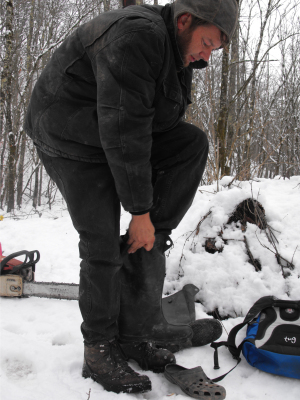 Monday
morning, I was bound and determined to get to town, if only to let my
mother know that we hadn't been wiped off the map. Mark and I
both geared up and filled our backpacks and hands with the bare
essentials --- chainsaw tools, mixed gas, empty gas jugs in case we
made it to town, my laptop for the same reason, two oranges in case we
got stranded on the way, and the chainsaw. We only have one pair
of waders between us at the moment, so Mark had to cross the creek,
change into his work boots, then toss the waders back across the cold
water to let me cross. I was very glad that he has a good
throwing arm.
Monday
morning, I was bound and determined to get to town, if only to let my
mother know that we hadn't been wiped off the map. Mark and I
both geared up and filled our backpacks and hands with the bare
essentials --- chainsaw tools, mixed gas, empty gas jugs in case we
made it to town, my laptop for the same reason, two oranges in case we
got stranded on the way, and the chainsaw. We only have one pair
of waders between us at the moment, so Mark had to cross the creek,
change into his work boots, then toss the waders back across the cold
water to let me cross. I was very glad that he has a good
throwing arm.
The driveway was just as
much work to clear as we'd thought. It took a couple of hours of
hard sawing and dragging to move the pines that had fallen across the
road, but the work was for naught. We got in the car...and
watched as its tires spun vainly on the icy snow.
 My
next thought was to walk to the neighbor's house a quarter of a mile
down the road and beg the use of their phone. The public road had
been plowed, but was seriously icy, making me glad that our little car
hadn't made it out of the driveway. Along the way, we ran into
another neighbor who gave us the bad news --- everyone in the area has
no power or phone. The electric company is hoping to restore the
juice by Christmas to those on the main road, which I figure leaves us
looking at New Years. Time to hunker down for the long haul.
My
next thought was to walk to the neighbor's house a quarter of a mile
down the road and beg the use of their phone. The public road had
been plowed, but was seriously icy, making me glad that our little car
hadn't made it out of the driveway. Along the way, we ran into
another neighbor who gave us the bad news --- everyone in the area has
no power or phone. The electric company is hoping to restore the
juice by Christmas to those on the main road, which I figure leaves us
looking at New Years. Time to hunker down for the long haul.
Stay tuned for part V soon. Meanwhile, check out our ebook that gives the secret of not worrying that your boss is going to fire you while you're incommunicado for a week or two.
This post is part of our Two Weeks Without Electricity series.
Read all of the entries:
|
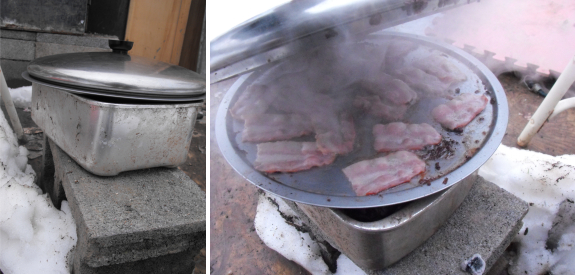
When we learned that
electricity was a long way off, I decided it was high time to start
really cooking rather than hastily heating up leftovers and hot dogs in
the wood stove. Our exterior wood stove is singularly ill-suited
for cooking, with a sleeve around the stove providing hot air to be
blown indoors and also preventing the surface from reaching cooking
temperatures. The inside is generally far too hot to cook in
without charring.
But I had nothing else
to keep me busy, so I decided to create my own Dutch oven. I dug
up an old roasting pan out of the barn, set it up on a cinderblock, and
filled it with hot coals shoveled out of the wood stove. A pizza
pan fit well on top, and a big lid enclosed the heated surface. I
had moderate luck "baking" chocolate chip cookies but great luck frying
up bacon. Maybe the latter tasted so good because of the bit of
leftover chocolate melding with the bacon juices?
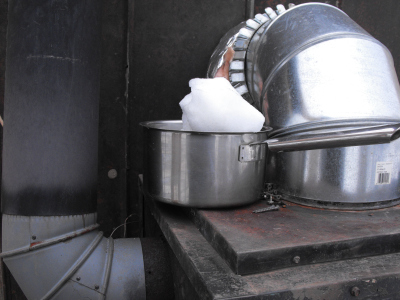 Meanwhile,
I was starting to get worried about our water situation. We still
had seven jugs of drinking water, but I could easily see us running out
and the dirty dishes were stacking up. I was pleased to discover
that packing a pot full to the brim and then half again as high with
clean snow melted down to a nearly full pot of warm dish water in three
hours on the wood stove. I added a bit of bleach for safety and
revelled in the feel of warm water on my hands as I cleaned up the
dishes.
Meanwhile,
I was starting to get worried about our water situation. We still
had seven jugs of drinking water, but I could easily see us running out
and the dirty dishes were stacking up. I was pleased to discover
that packing a pot full to the brim and then half again as high with
clean snow melted down to a nearly full pot of warm dish water in three
hours on the wood stove. I added a bit of bleach for safety and
revelled in the feel of warm water on my hands as I cleaned up the
dishes.
In a pinch, we probably
could have gotten away with drinking the melted snow, but our generator
made that unnecessary. We've allotted ourselves an hour and a
half of generator time every evening, plenty of time to turn on our
drinking water pump and UV light to fill up another dozen or so milk
jugs. And time to feed my blogging bug!
This is the last installment on the Monday CD. Stay tuned for more details soon (I hope.) Meanwhile, check out our microbusiness ebook.
This post is part of our Two Weeks Without Electricity series.
Read all of the entries:
|
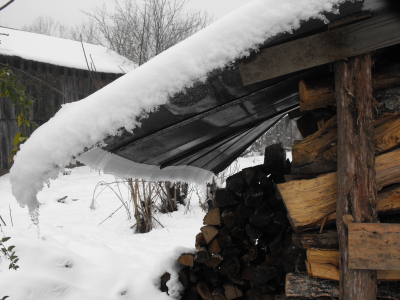 Monday
night as we read by solar flashlight, the telephone rang! I'm a
confirmed phone-o-phobe, but that sound was the nicest one I'd heard in
days. I leapt up and pounced on the receiver, then enthused in my
father's ear, called my Mom and sister, and even talked to my equally
phone-phobic brother.
Monday
night as we read by solar flashlight, the telephone rang! I'm a
confirmed phone-o-phobe, but that sound was the nicest one I'd heard in
days. I leapt up and pounced on the receiver, then enthused in my
father's ear, called my Mom and sister, and even talked to my equally
phone-phobic brother.
Earlier that day, I'd
resorted to putting a letter to my mother in the mailbox to assure her
that I was alive. When I got her on the phone, it was clear that
Mom had been worried, but she also told me how she'd often been snowed
in at my childhood farm and unable to contact her own mother for a
solid month. "No news is good news," Mom said...then admitted
that she'd emailed two of my neighbors to check on me.
Daddy gave me equally
good words of wisdom. "Isn't it nice to go without so that you'll
really appreciate power when you have it?" I have to admit that
in the past I've wished my ancestors hadn't opened up Pandora's box of
industrialization. But living without for just three days, I can
completely understand how we ended up in our current era of modern
conveniences.
Tuesday morning, the
phone was once again dead. Farewell, civilization!
One
of these days I'm going to get up to date, really.... For now,
though, enjoy reading our backstory, then check out our microbusiness ebook.
This post is part of our Two Weeks Without Electricity series.
Read all of the entries:
|
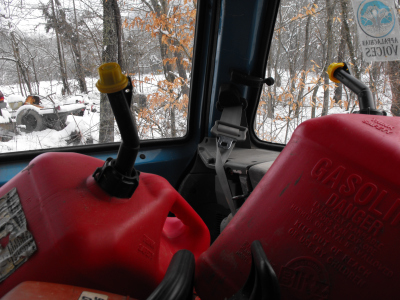 Despite
the phone dying again on Monday night, Tuesday was an outstanding
day. By mid morning, the sun started to poke through the clouds
that had kept the sky white for the last three days. Solar
radiation quickly started melting the snow, and it only took a bit of
hoeing to work our way out of the driveway.
Despite
the phone dying again on Monday night, Tuesday was an outstanding
day. By mid morning, the sun started to poke through the clouds
that had kept the sky white for the last three days. Solar
radiation quickly started melting the snow, and it only took a bit of
hoeing to work our way out of the driveway.
On the one year
anniversary of our marriage,
we ended up in the parking
lot of the same courthouse...but this time we were poaching
wireless. Our goals for this trip to town were really quite
simple --- we wanted to fill up some big jugs of gas so that we could
continue to run the generator an hour a day and I wanted to upload all
of my past posts (thus the poaching). While we were out, I
figured we should also stock up on some other essentials --- citrus,
chocolate, and flashlights.
Back home, we thawed out
the top of our wedding cake on the wood stove and ate it along with
some chicken cooked in my homemade
Dutch oven.
And then two miracles! First, an electric company employee came
wandering through our yard. He was lost and needed help reaching
the road, but the mere fact that he was scouting the downed power line
gave us hope (even though he said it may still be a week before we get
juice.) Finally, halfway through our generator hour, I picked up
the phone and heard a dial tone. Internet at home! Rapture!
You
all have been astoundingly patient with my shut-in, run-on blogs.
Now you're up to date! Starting tomorrow, we'll be posting in
real time (and will hopefully have a video to share with you.)
Meanwhile, check out our microbusiness
ebook for some Christmas reading.
This post is part of our Two Weeks Without Electricity series.
Read all of the entries:
|
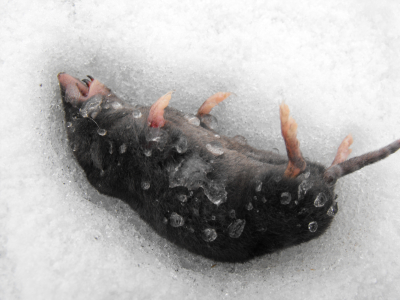 Lucy's worst trait is her tendency to dig up
garden beds, diving in and sending dirt and vegetables flying in every
direction. Usually, I berate her and grumble under my breath
about darn dogs, but lately I've had a change of heart. I've been
reading about how damaging mice and voles can be in the winter,
girdling young fruit trees. Granted, this guy that I found in the
snow near one of Lucy's manaical digging sprees is a shrew (meaning
that it eats insects and earthworms instead of plants), but I often
find dead rodents left in her wake as well. I wonder if she does
more good than harm with her digging episodes?
Lucy's worst trait is her tendency to dig up
garden beds, diving in and sending dirt and vegetables flying in every
direction. Usually, I berate her and grumble under my breath
about darn dogs, but lately I've had a change of heart. I've been
reading about how damaging mice and voles can be in the winter,
girdling young fruit trees. Granted, this guy that I found in the
snow near one of Lucy's manaical digging sprees is a shrew (meaning
that it eats insects and earthworms instead of plants), but I often
find dead rodents left in her wake as well. I wonder if she does
more good than harm with her digging episodes?
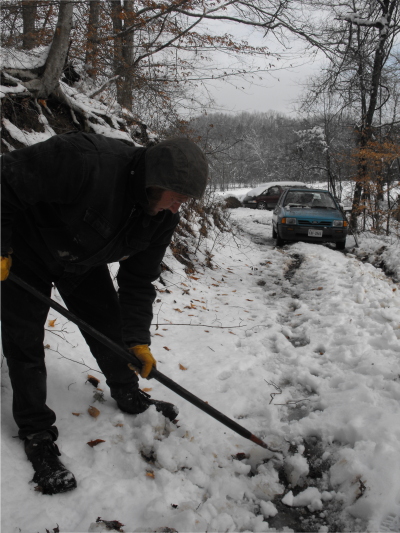 Our driveway snow was close to
melting, and this hoe method really worked in helping to break up the
icy spots where the Festiva was slipping in the ruts.
Our driveway snow was close to
melting, and this hoe method really worked in helping to break up the
icy spots where the Festiva was slipping in the ruts.
Lately when I've been using a hoe I can't help but to think of the
original Hobo from where the term came from. Hoe boys were a large
group of soldiers from the Civil war who came home to a devastated
farm. Most of them started traveling around with their hoes trying to
find a place to belong and perhaps a garden to tend to.
This is the image I've had since I heard the short explanation on a radio show, but it seems like nobody is exactly sure where the word came from if you can believe what Wikipedia says about the term.
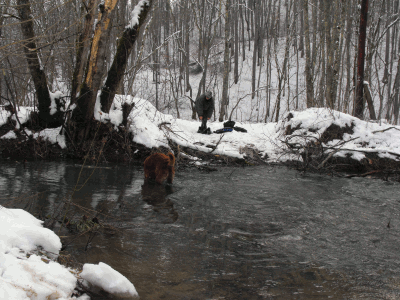 Someday, we'd like to be off the grid by
choice, so we've considered this extended (and still ongoing) power
outage as a useful dry run. It's been very helpful in giving us
an idea of infrastructure we need to be adding to the farm, and
reminding us which aspects of our electrified lives are really just
optional.
Someday, we'd like to be off the grid by
choice, so we've considered this extended (and still ongoing) power
outage as a useful dry run. It's been very helpful in giving us
an idea of infrastructure we need to be adding to the farm, and
reminding us which aspects of our electrified lives are really just
optional.
Here are the top
electricity-free items we've added to our wish list for next
year. Some are to buy, but a lot can probably be made from the
parts at hand.
- DC fan to keep the wood stove blowing hot air while the
generator's off. (Daddy suggested that we look into the fans that
cool off car engines --- we might be able to get one cheap at a
junkyard.)
- Alternator setup to get juice out of the golf cart so that we can run low electricity items (like the fan and maybe a router!) for much longer periods.
- Solar charger for the golf cart so that we can fill the golf cart batteries back up.
- Rocket stove (which we might be able to build) and a real Dutch oven for easy cooking.
- A second sub-zero sleeping bag so that we can both stay toasty during short-term emergencies.
- Solar LED lighting. You'd be amazed at what a difference it
makes to have enough light to read by on long, dark, electricity-free
nights. Flashlights have served us well, but we'd really like to
take some of those solar yard lights you can get so cheaply in the big
box stores nowadays and turn them into indoors lighting with the solar
panel outdoors for charging. Even though our current bulbs are
CFLs, I suspect that this would lower our electric bill during our
on-the-grid times too.
I also need to remember
to keep more library books on hand --- I'm starting to run a bit low,
which is a pain since the creek has flooded as the snow starts to melt
so I can't get to the library. We would have had a much easier
time with water, too, if we'd had the water line completely buried and
the big tank all the way full. Still, all told, I think we've
done pretty well so far.
When Mark mailed our
week's chicken waterers (made without the benefit of
electricity) this week, he overheard a lady in the post office
complaining about how difficult the power outage was since she couldn't
do her dishes. I feel so lucky that Mark's ingenuity has enabled
us to want for very little during this power outage!
This post is part of our Two Weeks Without Electricity series.
Read all of the entries:
|
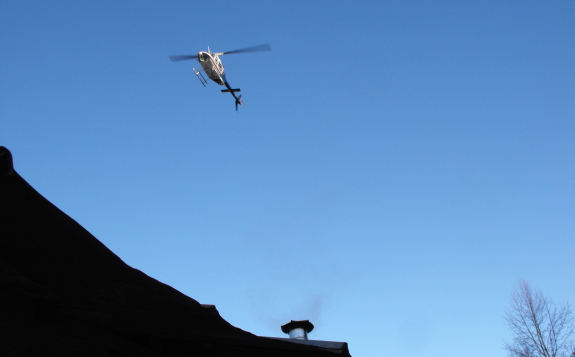
We had a visitor from the sky come out this afternoon just before
dinner. It seems like this iron bird was inspecting our downed power
lines, which gave us hope that we might get our power turned back
on before next year.
This post is part of our Two Weeks Without Electricity series.
Read all of the entries:
|

Instead of going visiting, we celebrated Christmas with a full day of generator power. It felt as sinful as living in a mansion, running a hot water heater 24/7, or buying an SUV --- a guilty pleasure. All day long, I was able to peruse the internet, try (in vain) to get our new camcorder working, and fill up drinking water jugs in anticipation of colder weather. The trailer got so warm from all of that fan action that I stripped down to my t-shirt and even managed to wash up for the first time in far too many days!
Over the course of the day, we discovered that the generator runs much longer on a tank of gas than I'd previously reckoned. The tank holds four gallons and the generator runs for about twelve hours on a full tank, so electricity by generator costs about a dollar per hour. Definitely not an every day splurge, but feasible on a special occasion.
This post is part of our Two Weeks Without Electricity series.
Read all of the entries:
|
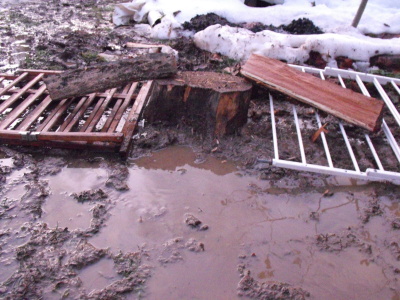 The snow is almost gone, which means mud, mud,
and more mud.
The snow is almost gone, which means mud, mud,
and more mud.
My mom gave us some baby crib pieces back in the summer left over from
an emergency turkey transport she was constructing which have really
worked out well as a catch for my wood splitting station.
It was a real bummer to watch a nice dry piece of firewood split its way directly in the mud.
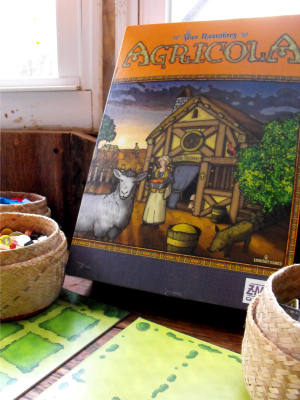 My
big brother arrived on Sunday bearing gifts! He looked just like
Santa, walking up the trail with his sack of goodies over his
back...except for the way his legs were bare from where he'd stripped
down to his underwear to wade through the creek.
My
big brother arrived on Sunday bearing gifts! He looked just like
Santa, walking up the trail with his sack of goodies over his
back...except for the way his legs were bare from where he'd stripped
down to his underwear to wade through the creek.
Mom and Maggie sent
delicious pies and treats and Joey brought a real, live Dutch
oven!!! Then he pulled out yet another package --- Agricola, a
great homesteading board game. The board looks just like the
dream farm I drew six years ago, where I allowed myself to pencil in
another square of orchard or pasture or creek every time I saved up a
thousand bucks for an acre. We played Agricola twice, then heated
up supper in the Dutch oven --- what a luxury!
As a certified
non-Christmas-gifter, I feel a bit hypocritical enthusing about my
gifts, but they sure made me happy. Thank you, everybody, for the
Christmas treats!
 Old
timey apples are one of my oldest loves. The first June apples,
translucent against the sun, are far too tender to sell in the grocery
store. We used to gather them from abandoned roadside trees, then
Mom turned them into the world's best applesauce and pies.
Old
timey apples are one of my oldest loves. The first June apples,
translucent against the sun, are far too tender to sell in the grocery
store. We used to gather them from abandoned roadside trees, then
Mom turned them into the world's best applesauce and pies.
In the winter, Daddy
would buy us Stayman Winesaps by the bushel.
We kept them in the basement with a bowl of sweet, tangy fruit always
at hand in the house. Since I was raised without sugared treats,
that crunchy fruit was like nectar.
When I grew up and left
the nest, I realized that most folks don't eat
real apples. They subsist on tasteless Red Delicious, insipidly
sweet Golden Delicious, or blandly sour Granny Smith.
Which is all to say that
I could see myself --- in another life ---
running an organic apple orchard full of unique varieties, just like
the one Michael Phillips documents in The
Apple Grower.
I've critiqued
his apple orchard microbusiness
over on our microbusiness blog, but over here I'm going to pull out the
gems that we small-time growers can learn from a master.
| This post is part of our Growing Organic Apples lunchtime series.
Read all of the entries: |
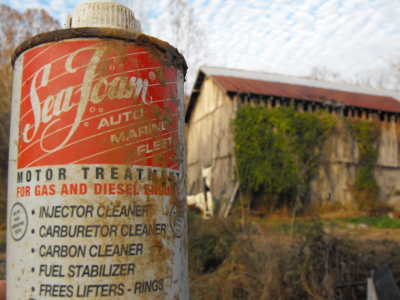 The Ford
Festiva stalling issue came back when the gas tank hit the 1/4
level point. Something the chainsaw repair guy said after he tuned up
our Stihl recently got me to thinking. His comment was that he had to
use his special carburetor bath 4 separate times to get all the gunk
cleaned out. This prompted me to give the Festiva another Seafoam
treatment, and it took over half the tank before the problem finally
went away, but it's running like it should now and it's all thanks to
Seafoam.
The Ford
Festiva stalling issue came back when the gas tank hit the 1/4
level point. Something the chainsaw repair guy said after he tuned up
our Stihl recently got me to thinking. His comment was that he had to
use his special carburetor bath 4 separate times to get all the gunk
cleaned out. This prompted me to give the Festiva another Seafoam
treatment, and it took over half the tank before the problem finally
went away, but it's running like it should now and it's all thanks to
Seafoam.
 The
most vivid part of the entire book is a quote from a nineteenth century
text about apples and bones. Roger Williams, the founder of Rhode
Island, was buried with his wife beside a large apple tree. The
tree was attracted to his bones and sent a root from his skull, down
his backbone to the hips, then divided in two to trace each leg.
The root bent at the knees and formed a man-like shape, in the process
digesting every bit of Roger Williams' body.
The
most vivid part of the entire book is a quote from a nineteenth century
text about apples and bones. Roger Williams, the founder of Rhode
Island, was buried with his wife beside a large apple tree. The
tree was attracted to his bones and sent a root from his skull, down
his backbone to the hips, then divided in two to trace each leg.
The root bent at the knees and formed a man-like shape, in the process
digesting every bit of Roger Williams' body.
From this anecdote,
Michael Phillips determined that apple trees like bones. In fact,
calcium is a limiting factor in the trees' fruit production, just as
it
is for tomatoes. If the proportions of calcium, magnesium,
and
potassium aren't just right in the soil, the apple tree may not be able
to suck up enough calcium and the fruits will develop bitter pit.
Poultry bones are, in
fact, one of the few waste products that shouldn't be a waste product
on our farm. I turn carcasses into rich stocks, but the stewed
bones are no longer safe for Lucy to consume, so we carefully bury them
out of her reach. Given apple trees' need for calcium, we've
started putting those carcass pits around our young apple trees in hope
that the trees roots will find the bones and suck up the precious
calcium. Maybe someday we'll dig up the apple roots and find them
curled into the shape of a bird.
| This post is part of our Growing Organic Apples lunchtime series.
Read all of the entries: |
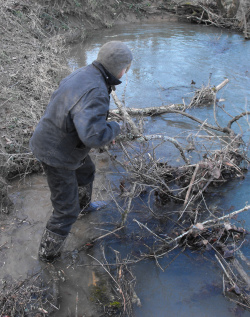
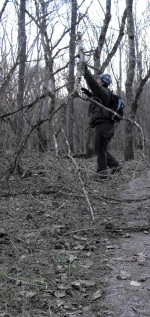 After
a week of hunkering down and getting by, we went back to work on Monday
morning. The first order of business was to clear the rest of the
driveway of fallen limbs. Last week, we just cut through the ones
between the car and the road, but I wanted to be ready to drive the
golf cart from the cars to the trailer to ferry in supplies. So
we pushed and pulled tree-sized branches out of the way to clear our
path.
After
a week of hunkering down and getting by, we went back to work on Monday
morning. The first order of business was to clear the rest of the
driveway of fallen limbs. Last week, we just cut through the ones
between the car and the road, but I wanted to be ready to drive the
golf cart from the cars to the trailer to ferry in supplies. So
we pushed and pulled tree-sized branches out of the way to clear our
path.
Later, we scooted across
the creek on a log to keep our feet dry. In the neighbor's field,
we ran into two more power company employees, scouts who promised that
the chainsawing guys weren't too far behind. I'm not quite sure
why it takes two separate on-foot scouting expeditions and a helicopter
to assess the damage, but I'm not complaining as long as the real
workers aren't too far behind!
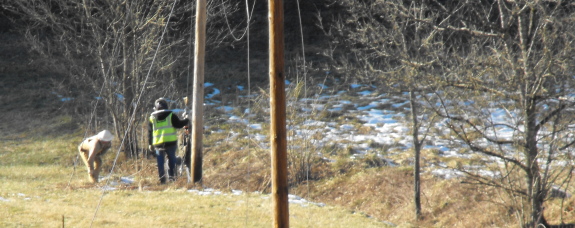
I spotted this small crew off in the distance while I was working
outside on the do it
yourself storage building project. It gave me a glimmer of hope
that something was going to get started today, but that was not
meant to be.
Maybe they're getting everything ready for an early start tomorrow?
This post is part of our Two Weeks Without Electricity series.
Read all of the entries:
|
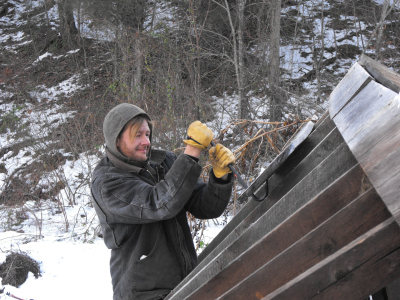 Rather
than getting his feet wet on Tuesday, Mark opted to tear down the old
house. I've
been poking away at this project a tiny bit at a time
as my wrists allowed, but Mark dove in with a vengeance. Before I
knew it, the roof was gone!
Rather
than getting his feet wet on Tuesday, Mark opted to tear down the old
house. I've
been poking away at this project a tiny bit at a time
as my wrists allowed, but Mark dove in with a vengeance. Before I
knew it, the roof was gone!
Now we've got wood to
create the roof supports on our new homemade
storage building.
The lumber is three quarters of a century old, but most of it is still
good and hard. The wood is probably oak or maybe even chestnut
and is significantly harder than the soft two by fours we buy at the
lumber yard.
| This post is part of our Building a Storage Building from Scratch
series.
Read all of the entries: Part 1: Foundation
Part 3: Walls and scavenging lumber
Part 5: The roof
|
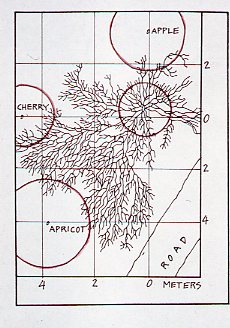 I
learned last week that the
worst thing you can do to your soil biology
is to grow grass under your fruit trees. So I was surprised
to
read that Michael Phillips grows grasses in his orchard. His
technique, though, is nothing like the often-mowed lawns found in other
orchards.
I
learned last week that the
worst thing you can do to your soil biology
is to grow grass under your fruit trees. So I was surprised
to
read that Michael Phillips grows grasses in his orchard. His
technique, though, is nothing like the often-mowed lawns found in other
orchards.
Michael uses gravel
directly around the base of his trees to prevent any weed growth.
Outside this gravel circle, he mulches his young trees with rotten
hay. Once the trees have reached bearing age, though, the
purchased mulch gives way to what he calls a sod mulch system.
Under these mature
trees, grasses and broad-leaved weeds are allowed to grow outside the
gravel ring until the petals fall from the apple flowers. Then
the groundcover plants are cut and the resulting hay is spread beneath
the trees, shading out most of the plants it initially grew from.
The quickly rotting hay combines with compost to give the apple tree a
quick boost of fertility, but the weeds are able to grow back through
the next spring to create another year's mulch.
A 1923 study showed that
this sod mulch system gave two to four times the yield compared to
simply growing lawn beneath the apple trees. On the other hand,
some apple varieties responded slightly better to the surrounding soil
being tilled and planted with a cover crop annually. I like the
direction I've been going in with comfrey under my fruit trees, but
sod
mulch would definitely be worth a shot if I was running an entire
orchard and needed to mechanize the process.
| This post is part of our Growing Organic Apples lunchtime series.
Read all of the entries: |
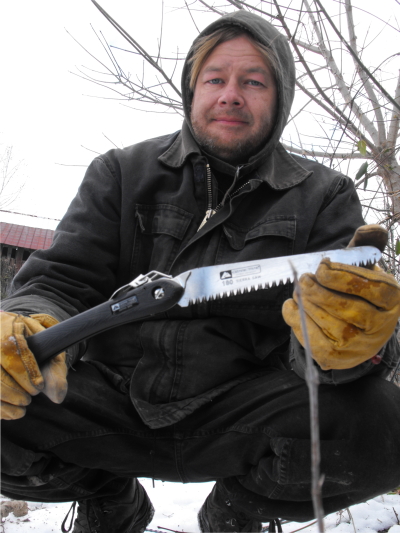
This hand saw might look a little on the cheap side with its plastic
handle and small size...but it cuts like the Dickens.
You will be impressed at how fast this thing can cut through a tree
limb.
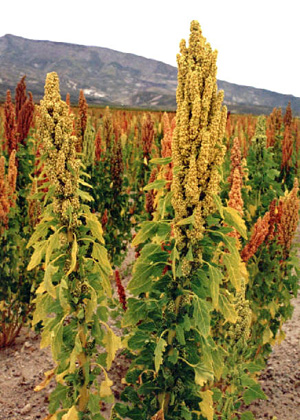 One of the biggest chinks in our food
independence is grain. We grow sweet corn and could grow field
corn though our consumption of corn meal is so low that the latter
doesn't seem like a good use of space. But we also buy masses of
wheat flour and rolled oats every year, along with some rice. Can
we become less dependent on commercial supplies of grain?
One of the biggest chinks in our food
independence is grain. We grow sweet corn and could grow field
corn though our consumption of corn meal is so low that the latter
doesn't seem like a good use of space. But we also buy masses of
wheat flour and rolled oats every year, along with some rice. Can
we become less dependent on commercial supplies of grain?
I've held off on planting grains because, frankly, I'm terrified of the
extensive process of cutting, threshing, winnowing, and what all.
Instead, I'm currently looking at two grains that used to be staple
crops for Native Americans --- quinoa and amaranth. It sounds
like both can be easily harvested by hand and their seeds aren't
covered with a hull, so they don't need extensive processing.
(Quinoa seeds are covered by a soapy substance called saponin that can
be removed by washing them in cold water in a blender, changing the
water five times or until it is no longer sudsy.)
Maybe I should splurge and buy some of the grain to eat first to see if
we like them, but I've heard they're both delicious cooked like rice,
and that amaranth can also be ground into a flour. Both are
higher in protein and lower in carbohydrates than more traditional
grains, which can't hurt.
Has anyone had luck growing quinoa or amaranth? I think we may
splurge and buy some seeds this year and give them a shot! (Can
you tell I'm in the midst of garden-planning for next year?)
 Apple
trees can take up to a decade to bloom and produce their first fruit,
so the rest of the book presents information I can only consider
theoretically. It sure is nice to dream about white apple
blossoms and growing fruits, though.
Apple
trees can take up to a decade to bloom and produce their first fruit,
so the rest of the book presents information I can only consider
theoretically. It sure is nice to dream about white apple
blossoms and growing fruits, though.
I was stunned to read
that an apple flower requires an average of 68 bee visits to ensure
proper pollination! It turns out that the multiple seeds inside
an apple need to be individually pollinated, and that a fruit with only
one or two seeds is likely to be dropped by the tree before it is
mature. Michael Phillips borrows honeybees to put in his orchard
at the critical period and sometimes even cuts his dandelion flowers
down to make sure the bees concentrate on apple blossoms. He also
encourages wild flowering plants at other times of the year to build up
his bumblebee
and orchard bee population.
Then, after carefully
getting as many of his flowers pollinated as possible (usually 1 in 8
will make fruit), he goes back to the orchard and manually thins the
tiny fruits to one apple per cluster. He also picks off fruits
until they are no closer together than four inches along the
branch. Thinning the apples about 35 days after full bloom helps
make sure his trees bear every year rather than lapsing into biennial
fruiting. He ends up with about the same weight of fruit as he
would without thinning, but the resulting apples are much larger.
| This post is part of our Growing Organic Apples lunchtime series.
Read all of the entries: |

We got our 5th visit yesterday from the electric company. I tried
appealing to this guy's sense of duty by casually mentioning that we've
had four other
visits, each ending with a bit of looking around and head
scratching at how deep our creek is.
"I didn't come all the way from North Carolina to just look around," he
calmly stated. His confidence filled us with with a newfound hope and
sure to his word the lines were back up before he headed back home last
night.
We spent the morning waiting, trying not to think of all the obstacles
that could be keeping the flow of cheap electricity from coming back to
our trailer when all of a sudden the hallway light came on and the
power outage of 2009 was officially over.
It's good to know we can get by without the grid, but this has been a
wake up call for us by pointing out a few areas we can improve upon for
a
more streamlined approach to off the grid living.
This post is part of our Two Weeks Without Electricity series.
Read all of the entries:
|
Want more in-depth information? Browse through our books.
Or explore more posts by date or by subject.
About us: Anna Hess and Mark Hamilton spent over a decade living self-sufficiently in the mountains of Virginia before moving north to start over from scratch in the foothills of Ohio. They've experimented with permaculture, no-till gardening, trailersteading, home-based microbusinesses and much more, writing about their adventures in both blogs and books.
